Microsoft RAB-3N PCS Band GSM Communicator User Manual Linda 2
Microsoft Mobile Oy PCS Band GSM Communicator Linda 2
Contents
- 1. Manual Part 1
- 2. Manual Part 2
Manual Part 2

199
Messaging
10. Messaging
Messaging contains the following applications: Fax, Mail and SMS (Short Message
Service).
To start Messaging, press the Messaging application button on the communicator
keyboard.
The overall requirements for using fax, mail and SMS, applications are as follows:
•The phone must be turned on.
•The system you are using must support fax calls, data calls, and the Short
Message Service.
•The fax, data and Short Message Service service must be activated for your SIM
card.
Tip: To set Internet
settings, see page 173. To
set Mail settings, see page
213.
•You must have obtained an Internet Access Point (IAP) from an Internet service
provider.
•You must have entered the proper Internet and Mail settings
•The short message center number must be stored in the settings of the SMS
application.
Contact your home service provider for details.
When you connect your communicator to a PC, you can synchronize your e-mails
with Microsoft Windows programs. You can also reply to and read remotely
Microsoft Windows and Lotus e-mail. For information on synchronization, see
‘Mail synchronization with your PC’ on page 225 and the PC Suite Guide.

200
Messaging
Messaging center
Figure 76
Tip: You can move
between the two frames
with the Arrows or Tab key.
The main view of Messaging has two frames: on the left is a list of the folders in
the Messaging center, and on the right are the messages connected to the
currently selected folder.
Folders in the Messaging main view are:
Inbox - Received faxes and short messages. Received mail appears in the Remote
mailbox folder.
Outbox - Messages which are waiting to be sent from the communicator.
Drafts - Saved message drafts.
Sent - Messages which have been sent from the communicator.
Any remote mailboxes that you set up appear at the bottom of the folder list.
Open folders and messages
To open a folder, select the left frame in the main view of Messaging, go to the
folder and press Open folder.

201
Messaging
Tip: You can also press
Enter to open messages and
folders.
To open a message, in the message list of the main view, go to the message and
press Open. The message opens in the appropriate viewer, for example, a mail
message opens in the mail viewer.
Manage folders
You can create your own folders in Drafts, in your own folders and in the root of
the folder list. You cannot create new folders in Inbox, Outbox or Sent.
Tip: You can create
folders to IMAP4 remote
mailboxes when online.
1Select the left frame in the main view of the Messaging.
2Press the Menu key and select File > Folder > Create new folder….
3Type a name for the new folder.
4Select where you want to create the folder.
5Press Create. The new folder appears on the folder list.
To move faxes, mail and short messages from one folder to another, select the file,
press the Menu key and select Edit > Move.
To search faxes, mail and short messages for names, dates, time, or any other
pieces of text press the Menu key and select Tools > Find…. For further details, see
‘Search for text’ on page 76.
Sort messages and faxes
You can also sort faxes, mail and short messages by various criteria, such as date
and size, which affects the way they appear in the different views of Messaging.
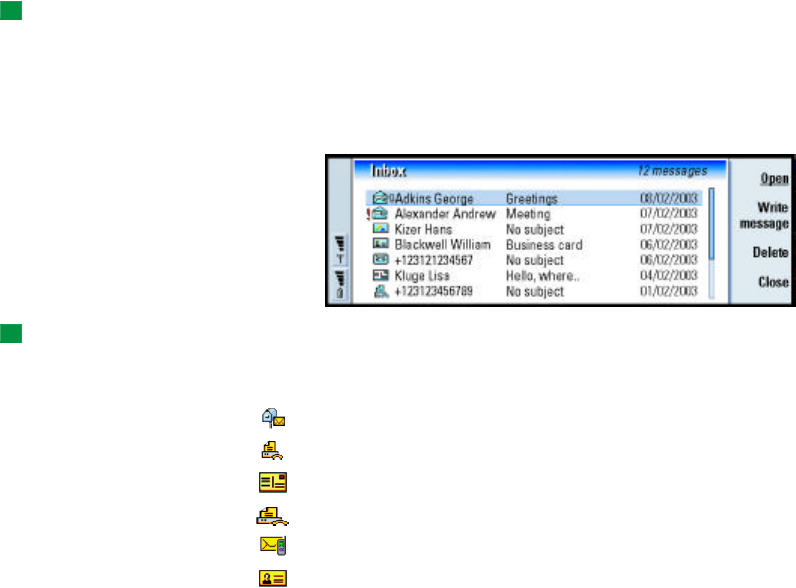
202
Messaging
Tip: To choose the sorting
order, press the Menu key
and select View > Sorting
order. Choose between
Ascending and Descending.
1Open the folder where you want to sort the messages and faxes.
2Press the Menu key and select View > Sort by.
3Choose from the following options: Message type/Sender/Recipient/Subject/Date/
Size/Priority.
Inbox
Figure 77
Tip: To reply to a message
in the Inbox, press the Menu
key and select Write > Reply.
Unread messages appear in bold.
The icons in front of messages indicate message type, priority and possible
attachments. Here are some of the icons that you may see:
new mail in remote mailbox
new fax
new short message (SMS)
new voice mail message
new message from your system service provider
new business card
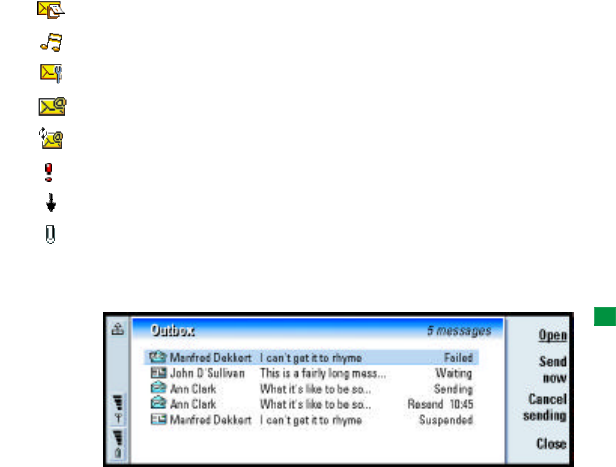
203
Messaging
new calendar invitation
new ringing tone
new remote configuration data
unread mail
unread mail received from PC by synchronization
priority high
priority low
message contains an attachment
Outbox
Tip: You can send faxes,
mail and short messages
immediately, at a predefined
time or upon request,
depending on a delivery
setting. See Sending
options in the
corresponding editors.
Figure 78
Statuses
Faxes, mail and short messages waiting to be sent from the communicator can
have the following statuses in Outbox:
•Sending - The fax or short message is currently being sent.

204
Messaging
Upon request - The mail, fax, or short message will be sent only if you specifically
press Send now in the Outbox view.
Waiting - The fax or short message is queuing to be sent and will be sent as soon
as possible, for example, when the phone is switched on, signal strength becomes
adequate, or the previous phone call ends. In the case of mail messages, Waiting
shows that the message will be sent the next time you connect to your remote
mailbox.
Calling - Outbox is calling the recipient of the fax message.
Preparing - Outbox is rendering a T.4 format fax image; this means that color is
converted to black and white.
Failed - One or more pages of a fax or short message failed to be sent.
Tip: If the status of a fax,
mail or short message is
Suspended, Resend or
Scheduled, you can open and
delete it, or resume sending.
Suspended -You have suspended the sending of the message or fax. You can resume
the sending of a message by pressing Send now in the Outbox view.
Resend - The fax or short message failed to be sent but the communicator will retry
to send it.
Scheduled - The fax or short message is scheduled to be sent at a specific time.
To cancel the sending of a fax, mail or short message, select it and press Cancel
sending.
When a message or fax has been successfully sent, it is automatically moved to the
Sent folder.

205
Messaging
Write and send faxes, mail and short messages
There are two ways you can start creating faxes, mail and short messages in the
Messaging application:
Tip: If you are already
writing a message or fax and
want to start on a new
message, press the Menu
key and select File > New
short message or New fax.
•Press any of the following commands in the main view of Messaging: Write
fax, Write mail or Write short message.
•Press the Menu key in the main view of Messaging and select Write > New
message…. Then select the appropriate message type.
You can also send send faxes, mail and short messages in all the applications
where you can find the option File > Send after pressing the Menu key.
Tip: When you start
writing a new fax, mail or
short message, a temporary
copy of it is automatically
stored in the Drafts folder. It
is removed from Drafts and
placed in Outbox once you
press Send.
If you want to save, but not send a fax, mail or short message you have just written
in the corresponding editor, press Close. The message is saved in the Drafts folder.
The saved message replaces the previously saved version of the same message. To
revert back to the previously saved version of the mail or fax, press the Menu key
and select File > Discard changes. Note that this is not possible with short messages.
Select recipients
There are two ways to select recipients to your fax, mail and short messages:
Note: A fax can have only one recipient.
1Press Recipient in the corresponding message editor. A dialog listing your
contacts opens, see figure 79.
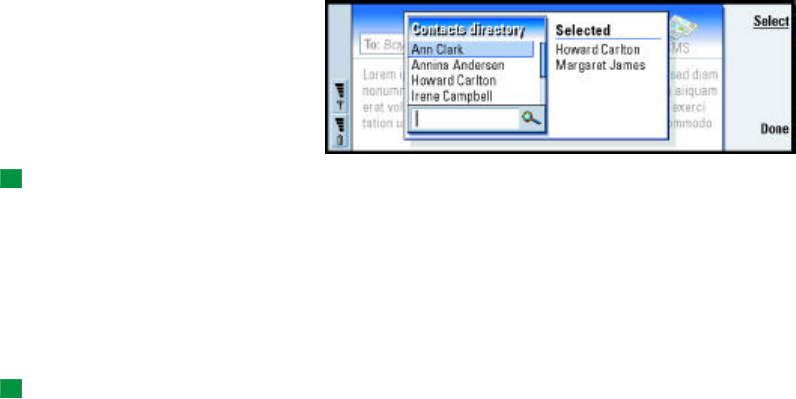
206
Messaging
Figure 79
Tip: You can select more
than one contact at a time,
see ‘Select several items at
once’ on page 72.
2Search for a contact or contacts in the left frame and press Select.
The right frame shows the contacts you have already selected; to remove a
contact, select it and press Remove.
3Press Done.
You can also just type in the first letters or the whole name of the recipient into
the header of the fax, mail or short message and check if the letters or name match
an entry in your contacts database:
1Type in the name of the recipient into the header of the message.
2Press the Menu key and select Tools > Check names.
Tip: In the case of mail,
you need to select the
contacts to the appropriate
fields in the dialog by
pressing To, Cc or Bcc.
3If the name you have entered matches to more than one name, or if the person
has more than one GSM phone number, fax number or mail address, a selection
list appears.
Select the correct name, phone number, or address from the list and press
Select.
Checked recipients are moved to separate lines in the header of the message.
Note that a fax can have only one recipient.
4To add another recipient to a mail or short message, press Enter after a checked
recipient or insert the semicolon “;” as a separator.

207
Messaging
To delete a checked recipient, move the cursor to the end of the entry and press
backspace.
Avoid low memory
You should regularly delete messages from your Inbox and Sent folders and delete
retrieved mail from the communicator memory to free up memory space.
WARNING! If you do not use this method to delete mail messages from your
communicator, the messages may also be permanently deleted
from your remote mailbox.
Tip: Use a PC mail client
to move mail messages from
your remote inbox to other
folders for archiving. If you
keep the number of
messages in the remote
inbox to a minimum, your
communicator has more
available memory and the
mail connection is faster.
To delete dowloaded mail messages from the communicator:
1Press the Menu key in the main view of Messaging and select Tools > Message
storage…. A dialog with two pages opens.
2On the Communicator page you can choose to delete all mail messages or
messages older than a given time period. To delete selected messages, press
Delete now. Messages are deleted from your communicator’s memory, but they
are not deleted from your remote mailbox.
On the Memory page, you can delete or move messages from the current store.
To change the store in use, press Change. To move the message storage from
communicator’s memory to a memory card or vice versa, press Move. To delete
all the messages in the selected message storage, press Delete.
Tip: See ‘Mail
attachments’ on page 223
to delete attachments from
received mail messages.
WARNING: Deleting the message storage deletes permanently all
messages and mailbox folders and restores all messaging
settings to factory defaults.
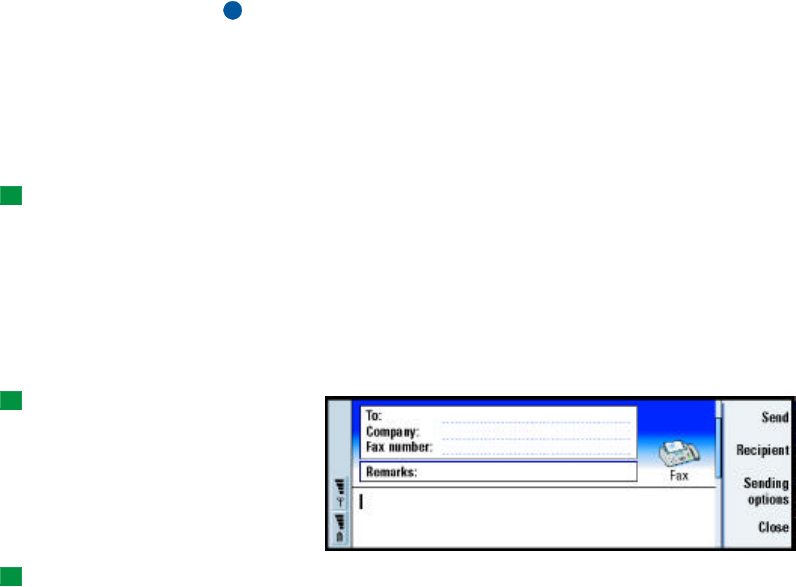
208
Messaging
Note: If you create a new message store to a memory card and remove the card
a new storage must then be created in the internal memory when new
messages are received. This leads to a situation where you cannot move
messages from one memory storage to another, since only one message
store at a time can be in use.
Fax
Tip: For more advanced
word processing, use
Document instead of the fax
editor.
You can write and send faxes in the fax editor.
You can write documents in the Document or Sheet applications and then send
them as faxes. It is also possible to send faxes with embedded images. For details
on images, see ‘Imaging’ on page 271.
Write and send a new fax
1Press Write fax in the main view of Messaging. The fax editor opens, see figure
80.
Tip: You can zoom in the
fax editor. Press the Menu
key and select View > Zoom
> Zoom in or Zoom out
Figure 80
Tip: To select a recipient,
see details on page 205.
2Write the fax.
To format the text, press the Menu key and select Format.

209
Messaging
3Press Recipient to select the recipient. A fax can have only one recipient.
Tip: To define a specific
date and time when the fax
will be sent, select Scheduled
in the Send fax option.
4If you wish to adjust the sending options of the fax, press Sending options. For
details, see Fax settings on page 211.
5Press Send.
Note: Voice calls are not possible when a fax is being sent or received.
Fax cover page
Tip: To define the default
format of the header in your
faxes, as well as whether
you want a cover template
to be attached to the faxes,
see ‘Fax settings’ on page
211.
You can attach a cover page to the fax you are currently creating or editing.
1Press Sending options and then select Fax cover page.
2Choose one of the following options:
None: The header of the fax will have only the To: and Fax number: fields.
Header: The header of the fax will have information about the sender and
recipient of the fax, and the date of the fax.
Template 1: The header field of the fax will have information about the sender
and recipient of the fax and a separate Remarks: field.
Full template: The header field of the fax will have more information about the
sender and recipient of the fax, the date of the fax and a separate Remarks: field.
You can save and use customized cover templates in the Templates folder using
File manager; for more information see page 246. Whatever cover template you
use, the available recipient information is filled in automatically.
Receive and read faxes
Tip: To forward a received
fax, press the Menu key and
select File > Forward.
Faxes are received automatically, provided that this service is available and that
the phone is turned on and within system coverage.

210
Messaging
When a new fax is received, you hear a tone - unless the system is set to a silent
profile - and an information note is shown on the display.
Tip: You can zoom and
rotate in the fax viewer.
Each press of Rotate rotates
the fax 90 degrees
clockwise.
Press Open to view the fax.
To open a fax received earlier, go to the Inbox, select the fax and press Open.
Note: If a fax is not received completely due to some failure, it is named
Incomplete fax.
Select and save all or part of a received fax
You can select all or part of a fax and save it in another format for further editing.
To select an area of a fax page:
1Press the Menu key in the fax viewer and select Tools > Selection frame. A
selection frame appears in the fax viewer.
2Use arrow keys to move the selection frame to the upper-left corner of the area
you want to select.
3To change the size of the selection frame, press and hold the Ctrl key and press
the Arrows key. To cancel the selection, press the Menu key and select Tools >
Selection frame again, or just press Esc key.
To save fax in another format
1Press the Menu key in the fax viewer and select File > Export…. Select the range
to be exported. The options are Whole document / Current page / Selected / User
defined. Press OK. A dialog opens.
2Specify the name and location of the new document. To change the format of
the new document, press Change format.
3Press OK to save the exported fax file.
211
Messaging
Fax polling
You can retrieve faxes from a remote fax box by using Fax polling, if available in
the system. It allows you to make a fax call to a fax machine and then receive
information by fax.
Retrieve faxes from a remote fax box
1Press the Menu key in the main view of Messaging and select Receive > Fax >
Dial fax poll.
2Type in the fax number for the remote fax box, or choose the number by
pressing Recipient.
3Press Call to call the number.
Fax settings
Any changes you make to fax settings affect the way in which your faxes are sent
and received.
1Press the Menu key in the main view of Messaging and select Tools > Account
settings….
2Select Fax and press Edit. A dialog with two pages opens. Define the following:
Settings page
Fax cover page: Defines whether or not a cover page will be used. The options are
None/Header/Template 1/Full template - In addition to the options above,
the option list may contain other cover templates saved in the Templates
folder.

212
Messaging
Send fax: Defines when the fax will be sent. The options are Immediately/Upon
request.
Advanced page
Resolution: The resolution of the sent and received faxes. The options are High/
Standard.
ECM: Defines whether or not the Error Correction Mode is used when faxes are
sent. If set to On, any pages containing errors are automatically returned
to sender, until the defects are corrected. The options are On/Off.
Resend: Defines which pages will be sent again if the fax sending has failed. The
options are All pages/Missed pages.
Mail
The Nokia 9290 Communicator mail system is compliant with Internet standards
SMTP, IMAP4 (rev 1) and POP3.
To be able to receive and send mail, you need to have set up a remote mailbox
service. This service may be offered by an Internet service provider, a system service
provider, or your company.
Tip: If you press Write
mail in the main view of
Messaging and you have not
set up your mail account,
you will be prompted to do
so.
Before you can send, receive, retrieve, reply to, and forward mail on your
communicator, you must do the following:
•You must configure an Internet access point (IAP) correctly. See ‘Setting up
your Internet access point’ on page 173
•You must define your Mail settings correctly. See ‘Mail settings’ on page 213.
Note: Follow the instructions given by your remote mailbox and Internet service
providers.

213
Messaging
Mail settings
Any changes you make to mail settings affect the way your mail is sent and
received.
To connect to your remote mailbox, you need to define a mail account on your
communicator:
1Press the Menu key in the main view of the Messaging center and select Tools
> Account settings….
2Press Create new. A selection list of possible account types opens.
3Select Mail and press OK. A dialog with four pages opens. See figure 81
Figure 81
4Define the following:
General page
Mail account name: The name of the remote mailbox. You can type here any name
to describe the mailbox.
My name: Type in your name.
Username: Type in your user name.

214
Messaging
Password: Type in your password. If you leave this field blank, you will be prompted
for password when you try to read mail in your remote mailbox.
My mail address: Type in the mail address given to you by your service provider.The
address must contain the ‘@’ character. Replies to your messages are sent
to this address.
Internet access: The IAP connection used for the mailbox. Choose an IAP from the
list. To create an IAP, see ‘Setting up your Internet access point’ on page
173.
Default account: Choose a mail account from the list. When you set up an account
for the first time, it will be the default until more accounts are created.
Servers page
Tip: Outgoing mail
servers are typically called
SMTP servers or hosts and
incoming mailservers are
called POP3 or IMAP4
servers.
Mail account type: Defines the mail protocol your remote mailbox service provider
recommends. The options are POP3 and IMAP4.
Outgoing mail server: The IP address or host name of the computer that sends your
Internet mail.
Incoming mail server: The IP address or host name of the computer that receives
your Internet mail.

215
Messaging
Retrieve
Tip: If you prefer reading
your mail messages and
replying to them while
connected to your remote
mailbox, select Mail headers
(stay online). If you prefer to
retrieve the messages and
disconnect, select Messages.
Retrieve: Specifies what will be retrieved from the remote mailbox when the
connection is established. The options are Mail headers (stay online)/
Messages/Messages and attachments. The Messages option is available only
if the mailbox type is IMAP4.
Max. size of mail: The maximum size of a message which is retrieved. The minimum
is 1 KB and maximum 1000 KB.
Sync. mails in Inbox: Specifies the number of message headers to be retrieved from
Inbox of the remote mailbox. The options are All/None or you can define
the appropriate number of messages to be retrieved.
Sync. mails in folders: Specifies the number of message headers to be retrieved from
the folders of the remote mailbox excluding Inbox. The options are All/
None or you can define the appropriate number of messages to be
retrieved.
Advanced page
Default mail type: The type of mail that you can write and send from your
communicator. The options are Plain text (no MIME)/Plain text/Formatted
text (HTML).
Send mail: How mail is sent from your communicator. The options are Immediately/
During next connection/Upon request.
Include signature: Specifies whether your signature is attached to sent mail. The
options are No/Use my contact card/Custom. If you choose Custom, you can
press Edit signature to modify the signature file.

216
Messaging
Request read report: The options are Yes/No. If you choose Yes, you will receive a
notification when the recipient has opened your mail. You can only
receive a notification if the recipient’s e-mail application supports this
feature.
Allow report requests: The options are Yes/No. If you choose No the sender of a
message you receive will not get a notification, when you open the
message.
Copy to my mail address: The options are Yes/No.
Secure login (APOP): Used with POP3 protocol to encrypt the sending of passwords
to remote mail server. The options are Yes/No.
Secure connection (TLS): Used with POP3, IMAP4 and SMTP protocols to secure the
connection to remote mailbox. The options are Yes/No.
IMAP4 folder path: Define the location of the IMAP mail folder here, if not defined
automatically. This option is available only if the mailbox type is IMAP4.
Edit an account
1Press the Menu key in the main view of Messaging and select Tools > Account
settings…. A list of accounts opens.
2Select the account you want to edit and press Edit.
3Define the settings on the General, Servers, Retrieve and Advanced pages
explained above.
4Press the Esc key to discard any changes.
Press Done to accept the changes you have made.
Note: You cannot edit mailbox settings when online.
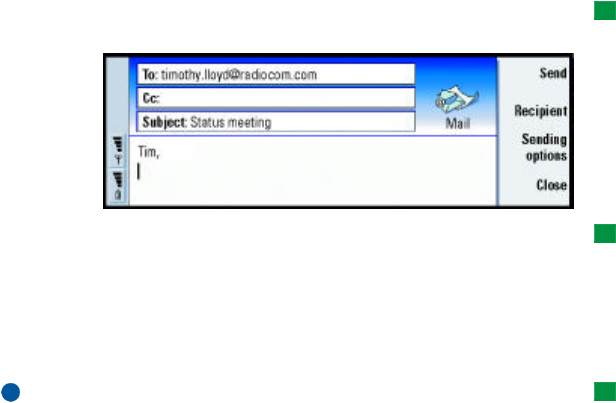
217
Messaging
Write and send new mail
Tip: If you cannot send
mail from your
communicator, check first
that your mail address is
correct in Mail settings. See
page 213.
1Press Write mail in the main view of Messaging. The mail editor opens, see
figure 82.
Figure 82
Tip: To see how to select
recipients, see page 205.
2Write the mail message.
3Press Recipient to select the recipient or recipients of the message, or type in
the name or mail address into the To:, Cc: and Bcc: fields. You can move from
one insertion field to another by pressing the Tab key.
4If you wish to adjust the sending options of the mail message, press Sending
options. A dialog with two pages opens, see page 219.
5Press Send.
Tip: You can zoom in the
mail editor.
Note: You cannot enter accented characters, such as é or ä, into mail addresses.
Recipients
There are three hierarchy levels of recipients in a mail message:

218
Messaging
Tip: To hide or show Cc:
and Bcc: fields in the mail
editor, press the Menu key
and select View > Show Cc
field or Show Bcc field.
To: - Message is sent directly to the recipient.Cc: - A copy of the message is sent to
the recipient, and the recipient’s name is visible to other recipients of the message.
Bcc: - A copy of the message is sent to the recipient, but the recipient’s name is
not visible to other recipients of the message.
.Note: The addresses you have entered are checked against your contacts
database once you press Send. Names which do not match with the
contacts database, or addresses which do not have ‘@’, should be
removed from the address fields.
If a name you have entered in one of the address fields matches a group name, the
name is replaced with the mail addresses of the group members.
Style of sent mail
You can format only HTML messages. Press the Menu key and select Format >
Formatting. This opens the following options for formatting: Bold, Italic, Underline
and Bullets.
Tip: To format the font
for a selected text area,
press the Menu key and
select Format > Font….
To set a preferred font for plain text and HTML mail, press the Menu key and select
Tools > Preferences….
To align a mail message, press the Menu key and select Format > Alignment. This
opens the following options: Left, Center and Right.

219
Messaging
Sending options
Tip: In the case of PC
mail message (see page
224), Priority and Mail
account in use are the only
options you can change.
The options in the Sending options dialog contain values set in mail settings, as
explained on page 219. Press Sending options to open the dialog. Any changes you
make in this dialog affect only the current mail message you are about to send.
Note: Changing the options in the Sending options dialog affects the format of
message when it is opened by the recipient. For example, the format may
affect the legibility of the characters.
Message page
Priority: The priority of a message. The options are High/Normal/Low.
Message type: The type of the message. The options are Plain text (no MIME)/Plain
text/Formatted text (HTML).
Request read report: Specifies whether to add to the outgoing mail, a request for
you to receive notification, if the recipient has opened your mail.
Delivery page
Mail account in use:
The remote mail service which is used for sending this message.
Note: Changing the mail account does not change the default options in other
fields of this page.
Send mail: When the message will be sent. The options are Immediately/Upon
request/During next connection.

220
Messaging
Retrieve mail
Tip: Delete mail regularly
from your communicator to
free up memory space. For
more information, see ‘Avoid
low memory’ on page 207.
Mail addressed to you is not automatically received by your communicator, but by
your remote mailbox. To read your mail, you must first connect to the remote
mailbox and then select the messages you wish to retrieve into your
communicator. Connection to a remote mailbox is established via a data call.
WARNING! Messages that you mark as deleted when offline will also be
deleted from the remote mailbox server, when online. To delete
local mail messages without deleting remote mailbox files, see
‘Avoid low memory’ on page 207.
Connect to a remote mailbox
1Select the remote mailbox in the left frame of the main view of Messaging.
Tip: If you do not specify
a password when initially
connecting to the remote
mailbox, a dialog opens.
Type in the password and
press OK.
2Press Retrieve mail.
3When the connection to the remote mailbox has been established, press the
Menu key and select Retrieve > New or Selected or All mail.
4When all the mail you have requested is retrieved, press Go offline.
Note: Pressing Go offline does not necessarily disconnect the phone, if there
are other applications open that use the connection. Press the Menu key
and select File > Disconnect to hang up.
Subscribe and unsubscribe to remote mailbox folders
•If your remote mailbox is of IMAP4 standard, you can edit and synchronize
remote inbox folders in your communicator. To do this, you need to subscribe
to the folders and make them visible in your communicator.

221
Messaging
Tip: To create new folders
in your remote mailbox, go
online, press the Menu key
and select File > Folder. You
can now choose whether to
Create new folder… or
Rename folder….
1Go online.
2Press the Menu key and select Receive > Folder subscriptions…. A list of folders in
the remote mailbox opens.
3Select the folder.
4Press Subscribe. If you have already subscribed to the folder, press Unsubscribe
to cancel the subscription.
5Press Go offline and Go online to include the new subscribed folders in the list.
Read mail
You can read, reply to and forward mail in the mail viewer.
To read received messages, select the message in the Inbox and press Open.
The mail viewer shows the message in a read-only state, which means that you
cannot edit it or the attachments linked to it.
If there is a Web link in the message, you can open it by going to that link and
pressing Use.
Tip: You can create new
contacts from the other
recipients of a received mail;
press the Menu key and
select Tools > Add to contacts.
If there is a fax, mail or short message link in the message, you can write a fax,
mail or short message by selecting the link and pressing the corresponding
command button. This opens the appropriate editor where the recipient field is
completed using the fax, mail address or GSM number in the link.
To delete the message, press Delete.
WARNING! Messages marked as deleted when offline will also be deleted
from the remote mailbox server, when online. To delete local
mail messages without deleting remote mailbox files, see ‘Avoid
low memory’ on page 207.

222
Messaging
Reply to mail
1Select the mail message in Inbox and press Open. The mail viewer opens.
Tip: To forward mail,
press the Menu key and
select File > Forward.
2Press Reply. The mail editor opens.
If you wish to reply to all the recipients, not just the sender of the mail message,
press the Menu key and select File > Reply to > All recipients.
Tip: To search and
replace text in a mail, press
the Menu key and select Edit
> Find….
3Edit the message in the mail editor and press Send.
Note: When replying to a mail message, HTML messages are included as
attachments.
Style of replied to, and forwarded mail
You can edit the style of replied to, and forwarded mail.
1Press the Menu key and select Tools > Preferences…. A dialog opens.
2Define the following:
Include message in reply: If you choose Yes, the original message is included in the
reply to the message. The options are Yes/No.
HTML normal font: Defines the default font size and family used in HTML messages.
Note that HTML messages may contain tags that change what you set in
this option.
HTML font size: Defines the size of the font used in HTML messages.
Plain text font: Defines the font used in plain text messages.
Plain text font size: Defines the size of the font used in plain text messages.

223
Messaging
Mail attachments
You can send most documents and messages you write in the other applications
of your communicator as mail attachments.
WARNING! Mail attachments may contain viruses or they can otherwise be
harmful to your communicator or PC. Do not open any
attachment, if you are not sure of the trustworthiness of the
sender. For more information, see ‘Certificate manager’ on page
262
Add mail attachments
Tip: To edit mail
attachments, press the
Menu key and select
Attachments > Edit. You
cannot edit attachments in
received mail messages.
1Press the Menu key in the mail editor and select Attachments > Insert file….
2Search and select the file you wish to attach to the mail.
View and save mail attachments
Attachments always appear at the bottom of an open mail message.
You can view the attachments using the appropriate viewers, if available.
Tip: To open an
attachment for viewing,
select it with the Arrows key
and then press Enter.
1Open the mail message containing attachments and press Attachments. A
dialog opens.
Press Open to open the attachment for viewing.
Press Save to save the attachment.
Press Delete locally to delete the attachment from your communicator; the
attachment is not deleted from your remote mailbox.

224
Messaging
Working online and offline
Working online means working with your communicator connected to a remote
mailbox via Internet connection.
When you work offline which means that your communicator is not connected to
a remote mailbox, you can delete only messages, not folders. When online, you can
delete, rename or create new folders in your remote mailbox.
Note: Any changes you make in the remote mailbox folders while offline take
effect in your remote mailbox the next time you go online and
synchronize. For example, if you delete a mail message from your
communicator when offline, the message will be deleted from the
remote mailbox the next time you connect to the mailbox.
If you want to delete a message from your communicator to save memory, see
‘Avoid low memory’ on page 207.
Managing your mail offline enables you to save in connection costs and work in
conditions that do not allow data connection, such as on aircraft. For information
about using communicator on an aircraft, see ‘Flight profile’ on page 133.
Remember also relevant warnings, see ‘Important safety information’ on page 309.
PC Mail
Whereas you can send and receive Internet mail over a data call, you cannot send
PC mail from the communicator. PC mail is mail you can read, write and edit on
your communicator, but which you can send and receive only through a PC, the
next time you synchronize your communicator with the PC.

225
Messaging
Mail synchronization with your PC
Synchronization is the process of making the contents of your mail messages and
mail folders identical on both your communicator and your PC. This is done by
copying and combining information between the two machines. For more
information, see PC Suite Guide on the sales package CD-ROM.
Tip: Before you can
synchronize your mail, you
must install PC mail
software from the sales
package CD-ROM. See
‘Install software from the
CD-ROM’ on page 81.
Mail synchronization copies the messages between your communicator and your
PC E-mail program to allow you use either machine for reading and replying to
messages.
You can convert Internet mail to PC mail so that it is synchronized with a PC, or
convert PC mail to Internet mail so that it can be sent directly from the
communicator. All synchronization settings are defined on the PC. The only setting
you can do on your communicator is to delete the account you are using.
Create new PC mail
Note: You need to have set a mail account on your remote PC to be able to
create new PC mail.
1Press the Menu key in the main view of Messaging and select Write > New
message…. A selection list appears.
2Select PC mail and press OK.
If you have more than one PC account, a dialog opens indicating which PC
account will be used when sending the PC mail. Select the PC account and press
OK.
3Write the PC mail in the mail editor.

226
Messaging
Convert to PC or Internet mail
Tip: You can view and
edit PC mail just like
Internet mail on your
communicator.
Note: HTML messages cannot be converted since PC mail does not support the
sending of HTML messages. You must change the message type to plain
text or non-MIME type in the Sending options dialog, before you can
convert the message to PC mail. See page 226 for more information.
PC and Internet mail appear together in the folders.
1Select the mail message or messages you wish to convert.
Tip: PC mail is
distinguished from Internet
mail by a different icon.
2Press the Menu key and select Tools > Convert to internet mail or Convert to PC
mail, depending on the type of mail you wish to convert.
3If there are multiple PC mail or SMTP services defined, a selection list of
available services defined in the messaging server will be shown. Select the
service and press Convert.
Note: You can convert several mails at the same time, but make sure that the
mails are of the same type, either Internet or PC mail.
Short Message Service
Tip: Your service provider
may send you smart
messages in the form of
short messages; these
messages may include, for
example, configuration
settings. For details, contact
your service provider.
The Short Message Service (SMS) enables you to send and receive short messages
over the digital wireless system.
Short messages can be sent or received even during voice, data, and fax calls.
Messages can be read in any mobile phone that has the capability. If the receiving
phone is switched off at the time of sending, the short message center continues
to attempt to send the message until the validity period allowed by the system
expires.
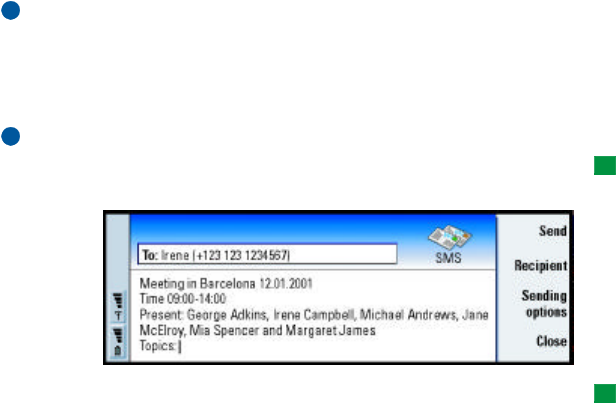
227
Messaging
Note: If you want to send text you have written or edited in another application
as a short message, all embedded objects or any rich formatting will be
lost. You cannot send attachments as short messages, either.
Write and send a new short message
Note: You cannot change the font, style or format of short messages.
Tip: When sending a
short message that contains
special or accented
characters to an older
mobile phone, the older
phone may not be able to
view the message. In this
case, send the message
without special or accented
characters.
1Press Write short message in the main view of Messaging. The SMS editor
opens, see figure 83.
Figure 83
Tip: You can zoom in the
SMS editor. Press the Menu
key and select View > Zoom
> Zoom in or Zoom out
2Press Recipient to select the recipient, or type the number directly into the
header of the message.
3Press the Arrows key to move down to the message field and write the short
message.
To view the length of the current message, press the Menu key and select View
> Message length.

228
Messaging
Tip: To define a specific
date and time when the
short message will be sent,
select Scheduled in the Send
short message option.
4If you wish to adjust the sending options of the short message, press Sending
options. A dialog with two pages, Sending options and Advanced opens. For
details, see SMS settings on page 229.
5Press Send.
Receive and read short messages
Tip: Your Inbox shows
the date of received short
messages and the time of
the short messages received
on the current day. To view
when it was sent, open the
message in the SMS viewer.
Short messages are received automatically, provided that this service is available
and that the phone is on and within system coverage.
When a new short message arrives, a tone will sound - unless the device is set to
a silent profile - and an information note is shown on the display.
The SMS viewer shows the message in a read-only state, which means that you
cannot edit it.
Tip: To create a contact
card of the sender of a short
message, press the Menu
key and select Tools > Add to
Contacts….
Received short messages can also contain some special text strings such as URLs.
If a URL is highlighted when you move the cursor over it, you can open the
corresponding link by pressing Use.
Reply to short messages
Tip: When replying to a
message, you can choose
whether you want the text
of the received message to
be in the reply. Select No in
Include original in reply in
SMS settings to minimize
the length of the reply.
Open the message, press Reply and write another short message.
If the received message has a reply path, the note Reply via same center is shown in
the header of the message.
Short messages on the SIM card
To move and copy messages from the SIM card to the Inbox, press the Menu key
and select Receive > Short message > SIM messages. To move, copy or delete
messages, press the corresponding command button.

229
Messaging
SMS settings
Any changes you make to SMS settings affect the way in which your short
messages are sent and received.
1Press the Menu key in the main view of Messaging and select Tools > Account
settings….
2Select Short message and press Edit. A dialog with two pages opens. Define the
following:
General page
Press Service centers, which opens a dialog where you can define new message
centers, as well as edit and delete existing ones. All message centers are listed by
name and number.
Service center in use: Defines the service center that is used for delivering the short
messages.
Tip: To open the system
log, press the Menu key and
select Tools > Log.
Delivery report: If you choose Yes, you can view the status of the sent message
(Pending, failed, Delivered) in the system log. If you choose No, only the
status sent is shown in the system log.
Send short message: You can select when you want the message to be sent. The
options are Immediately/Upon request/Scheduled. When Scheduled is
selected, you must define a Date.
Validity period: If the recipient of a message cannot be reached within the specified
validity period, the message is removed from the short message service
center. If Maximum is chosen, the validity period is set to the maximum
value allowed by the message center. Note that the system must support
this feature. The options are 1 hour/6 hours/1 day/1 week/Maximum.
230
Messaging
Advanced page
Reply via same center: This system service allows the recipient of your short
message to reply using your message center. If you chooseYes and the
recipient replies to your message, the return message is sent using the
same service center number. This requires that the recipient has
subscribed to the Short Message Service, is able to a reply to a message,
and uses a device which supports this feature. Note also that the system
must support this feature.
Include original in reply: Specifies whether text in the received short message is
quoted when you make a reply. If you chooseYes, the contents of the
message body are copied to a new short message.
Concatenation: If set to No, messages longer than 160 characters are sent as
several short messages. If set to Yes, messages that are longer than 160
characters are sent as several messages, but if the recipient has a Nokia
communicator, the messages are received as one long message.

231
Office
11. Office
Office contains the Document, Sheet, and Presentation viewer applications, which
are all compatible with Microsoft Windows. Office also contains a File manager
application for file and folder management tasks like moving, copying, and
renaming files and folders.
Figure 84
Document
You can use Document to write new and edit existing text documents. You can
insert and view images and other files in the documents. You can also send and
receive documents as fax, SMS, mail, PC mail, or via infrared.
Document can open documents created with recent versions of Microsoft Word for
Windows. Note that not all features and formatting of the original documents will
be supported. Documents made with other versions of Microsoft Word may only
be viewed. You can also save documents made with the communicator in
Microsoft Word format. For information on other file format conversions, see the
PC Suite Guide on sales package CD-ROM.
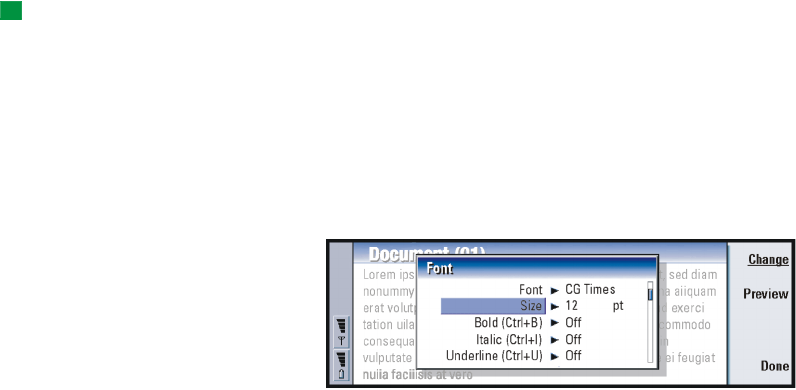
232
Office
Create a new document
Tip: You can use the
clipboard command
shortcuts Ctrl+x, Ctrl+c, and
Ctrl+v to cut, copy, and
paste text.
When you open the Document application, a new document is opened. You can
start writing immediately.
You can modify the style of a document on a font and a paragraph level. You can
use different fonts, font sizes, and styles. You can apply different predefined or
user-defined styles by either modifying particular pieces of text separately or by
using a template on which the style of the text is based (see page 234).
Change fonts
1Press Font in the document you are creating or editing. A dialog opens, see
Figure 85.
Figure 85
2Press Change to change the value of a list item.
To see the effect of the changes you have made, press Preview.
3Press Done to save the changes you have made.
Change text style
1Select the text whose style you want to change.
2Press Style. A list of choices in alphabetical order opens.
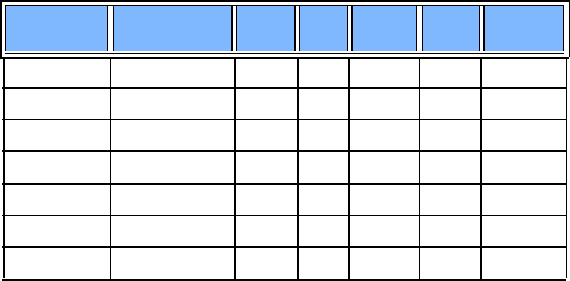
233
Office
3Select a style option from the list and press Set:
These are the default values of the style options in the list:
Create a new or modify an existing style option
1Press Style.
2To create a new style option, press New. Or, to modify a style option, select the
style and press Edit. A dialog opens.
3Give the style option a new name by typing over the old name. Note that you
cannot edit the names of the default styles.
Press Format to view a list of style values you can change.
4Press Change to change the values of the following: Font, Alignment, Indents,
Tabs, Line spacing, Borders, Bullets, and Outline level.
5Press Done to confirm the changes.
Style option Font Point
size Bold Italics Under
lined Justifica-
tion
Normal URW Sans 12 pt Off Off Off Left
Header URW Sans 10 pt Off Off Off Left
Footer URW Sans 10 pt Off Off Off Left
Heading 1 URW Sans 16 pt On Off Off Left
Heading 2 URW Sans 14 pt On Off Off Left
Heading 3 URW Sans 12 pt On Off Off Left
Title URW Sans 18 pt On Off Off Centered

234
Office
Templates
Example: You may have a
company template which
shows the company name
and defines a particular
layout.
You can use templates and save documents as templates when creating and
editing documents.
To select a template, press the Menu key and select File > Templates > Select
template…. A list of available templates opens. Select a template and press OK.
To save a document as a template, press the Menu key and select File > Templates
> Save as template….
To delete a template, go to File manager. See page 246.
Insert an object
Tip: To resize an image
after insertion, press the
Menu key and select Edit >
Object > Object details….
1Press Insert object in the document you are creating or editing. A dialog opens.
See Figure 86.
Figure 86
2Select from the list the type of object you want to insert.
3Press Insert new to open the corresponding editor.
Press Insert existing to open a list of files. Only files which you can insert are
listed.

235
Office
Note: Objects in a document are not links but embedded attachments, which
may increase the file size of the document dramatically.
Hide or make visible text markers
To hide or make visible markers that are used in editing within the document,
proceed as follows.
1Press the Menu key and first select Tools > Preferences…. A dialog with two
pages opens.
2Set the following options on or off:
Basic options page: Show tabs, Show spaces, and Show paragraph marks,
Advanced options page: Show forced line breaks, Show non-breaking spaces, and
Show hard hyphens.
View the outline of a document
Tip: To open a specific
page in the document, press
the Menu key and select
Tools > Go to….
1Press the Menu key and select View > Outline…. A tree structure of the
document opens.
2To show more details, press Expand.
To show less details, press Collapse.
To open a selected point in the document, press Go to.
3Press Close to return to the document view.
Paginate
After creating a new document, you can divide it into pages. Press the Menu key
and select Tools > More > Paginate. This command will also update the page
numbering.

236
Office
Sheet
In Sheet you can work and store your data in a file that is called a workbook. Each
workbook contains at least one worksheet. A workbook can also contain
chartsheets; a chartsheet is a spreadsheet file containing a chart that is based on
data from a worksheet.
Sheet can open files created with recent versions of Microsoft Excel for Windows.
Note that not all features and formatting of the original files will be supported.
Files made with other versions of Microsoft Excel may only be viewed. You can also
save files made with the communicator in Microsoft Excel format. For information
on other file format conversions, see the PC Suite guide on the CD-ROM.
Workbooks
Tip: To add a workbook to
the Desk application, press
the Menu key and select File
> Add to Desk.
To create a new workbook, press the Menu key and select File > New workbook.
To open an existing workbook, press the Menu key and select File > Open.
To save a workbook, press the Menu key in the worksheet view and select File >
Save.
To send a workbook as mail or via infrared, press the Menu key in the worksheet
view and select File > Send.
Worksheets
To create a new worksheet in a workbook, press the Menu key and select Insert >
New worksheet.

237
Office
Entering data
To enter data, select a cell with the Arrows key and start typing the data in the
selected cell.
To confirm what you have entered into a cell, press Enter, OK, or go to another cell
with the Arrows key. To dismiss the action, press Esc or Cancel.
You can also enter a formula to perform operations on worksheet data. Sheet
application provides some predefined, or built-in, formulas, which are know as
functions.
To insert a function, press Insert function. A dialog opens. See Figure 87. The
function categories you can choose from are as follows: All, Financial, Date and time,
Mathematical, Statistical, Lookup, Text, Logical, and Information. Each category has a
set of functions, which you can see from the list next to Function name. Select the
function you want and press Close.
Figure 87

238
Office
Example: You might want
to sum up figures in cells C2
to C4 in cell C5; select cell
C5, press Point reference
and select the cell range
from C2 to C4. Press Enter or
OK to confirm the action.
The SUM will now appear in
C5.
In a formula, you can enter constant values or cell references. A cell reference tells
Sheet where to look for the values or data you want to use in the formula. To enter
a reference to a cell or cells in a formula:
1Go to the cell you want to edit, and press Edit.
2Move the cursor to the place where you want to insert a reference, and press
Point reference.
3Select the cells that contain the values you want to use. See ‘To select cells’ on
page 135. The focus remains in the cell you are editing. Press Enter or OK to
confirm the action.
Figure 88
Selecting cells
There are two ways to select a cell or a range of cells in a worksheet:
Example: To select column
A, enter A:A. To select row 1,
enter 1:1. To select columns
B and C as well as rows 2
and 3, enter B2:C3
•Press the Menu key and select Edit > Select. Then enter the selection range or
choose a range from the list.
•Press and hold the Shift key, and increase the selection frame with the Arrows
key.
To select entire rows or columns, press and hold the Shift key, and select the
desired row or column headings with the Arrows key.
To select the entire worksheet, use the shortcut Ctrl + A.

239
Office
The selection is cleared when you press the Arrows key or Tab key.
Insert cells
1Select a number of cell(s) that you want to insert into the worksheet.
2Press the Menu key and select Insert > Cells. A dialog opens.
3Define whether you want the inserted cell or cells to appear above (Shift cells
down) or left (Shift cells right) of the selected range.
To insert an entire row(s) or column(s), select either Entire row or Entire column.
4Press OK to accept the insertion and Cancel to dismiss it.
Sort cells
You can rearrange the order of cells from top to bottom and left to right.
1Select the range.
2Press the Menu key and select Tools > Sort.
3Select either Top to bottom or Left to right. A dialog opens.
4Define the sorting criteria.
5Press Close to do the sorting.
Search for data
1Press the Menu key and select Edit > Find. A dialog opens.
2In the Find: field, enter the string you want to search for.
Tip: Pressing Options
opens up the following
options: Search in values,
Search in formula, Match case,
Find entire cells only , Direction,
and Search by.
3Press Find to search for the string.
Press Options to search the worksheet according to certain criteria.
Press Replace to replace the string with something else.
Clear cells
1Choose the cell or cells you want to clear.

240
Office
2Press Clear. A lists of choices appears.
3To clear both the contents and formats of the cell or cells, select All.
To clear only the contents of the cell or cells, select Contents.
To clear only the formats of the cell or cells, select Formats.
Adjust column width or row height
1Select the column(s), or row(s).
2Press the Menu key and select Format > Column width… or Row height….
3To increase column width, press > on the Arrows key as many times as
necessary. To diminish column width, press <.
To increase row height, press ∨ on the Arrows key as many times as is necessary.
To diminish row height, press ∧.
To adjust the width or height by exact figures, press Define width.
Figure 89
Align cell contents
1Select the cell or cells.
2Press the Menu key and select Format > Alignment. A dialog opens.
3Define the following options: Horizontal, Vertical, and Wrap text to cell.
241
Office
Change the appearance of cell borders
1Select the cell or cells.
2Press the Menu key and select Format > Cell appearance > Borders. A dialog
opens.
3Define the following options: Outline, Top, Bottom, Left, Right, and Line color.
Change number format
1Select the cell or cells.
2Press the Menu key and select Format > Numbers. A dialog opens.
3Choose the required format from the list. Depending on the format you choose,
you may define the place of the decimal.
Change fonts
1Select the cell or cells.
2Press the Menu key and select Format > Font. A dialog opens.
3Press Change to change the value of a list item.
4To see the effect of the changes you have made, press Preview.
5Press Done to save the changes you have made.
Change background color
1Select the cell or cells.
2Press the Menu key and select Format > Cell appearance > Background color. A
dialog opens.
3Choose the color.
Insert page breaks
1Press the Menu key and select Insert > Page break. A dialog opens.

242
Office
2Define the following options: Break at column and Break at row.
Note: Since the break is placed above and on the left side of the selected cell,
you cannot insert a page break when the cell A1 is selected.
Name cells
Tip: To change viewer
preferences, press the Menu
key and select Tools >
Settings. Set the following
options on or off: Show
gridlines, Show row headers,
Show column headers,
Automatic recalculation,
Show zero values, and Show
pagination lines.
1Select the cell or cells.
2Press the Menu key and select Insert > Name > Add. If the cell or cells already
have a name, you can edit the name by selecting Edit. A dialog opens.
3Enter the name.
Name worksheets
1Press the Menu key and select Edit > Rename worksheet. A dialog opens.
2Choose the worksheet from the list and name it.
Delete cells, columns, rows, page breaks, and worksheets
1Select a cell within the area you want to delete.
2Press the Menu key and select Edit > Delete. A dialog opens.
3Choose from the list what you want to delete.
Go to any sheet or chart within the same workbook
Tip: To view sheets in the
Chartsheet view, press
Sheets/ Charts.
1Press the Menu key and select View > Worksheets or Sheets/Charts. A list opens.
2Choose a sheet or chart and press OK to open the sheet and Cancel to dismiss
it.
Note: You cannot change the order of the sheets.

243
Office
Chartsheets
Create chartsheets
There can be seven different kinds of charts: Line, Column, Stacked column, Bar,
Stacked bar,X/Y scatter, and Pie.
1Select a range of cells on a worksheet. These will provide the data for your new
chartsheet.
2Press the Menu key and select Insert > New chart. A dialog opens.
3Define the following: Chart name, Chart type, 3-D, Background color, and Axis
color.
4Press Close to create a new chartsheet and Esc to dismiss it.
Edit chartsheets
Tip: You can also press
the Tab key and Enter to
select objects. Press Esc to
cancel the selection.
1Press Select object. A dialog opens.
2Choose an object from the following list for editing and press OK: Chart, Chart
title, X-axis,Y-axis, X-axis title, Y-axis title, Legend, Major X-axis gridlines, Minor X-
axis gridlines, Major Y-axis gridlines, Minor Y-axis gridlines, and Series. The setting
dialog for the selected object opens. See Figure 90 for an example of X-axis
settings being edited.
3To edit the object, press Change or press Enter. A dialog opens.
To delete the object, press Delete.
4Define the new values.
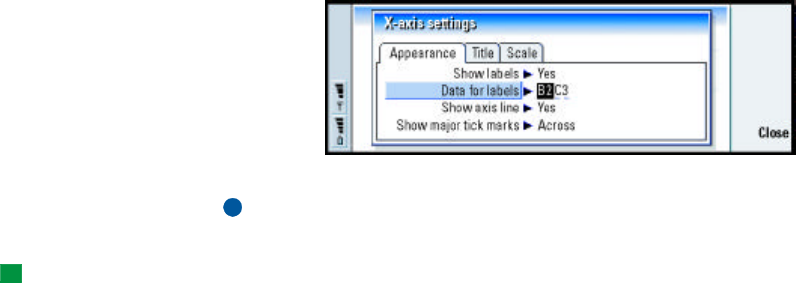
244
Office
Figure 90
5Press Close to confirm the changes or Esc to dismiss them.
Note: You can select only one object at a time.
Replace chartsheet data
Tip: To define the general
appearance of a chart, press
Chart settings. Define the
page style and name in the
two pages of the dialog
which opens.
You can replace the data on which your chartsheet is based.
1Press Sheets/ Charts and select the worksheet your chart is based on.
2Select a new data area for the chart from the worksheet, press the Menu key,
and select View > Sheets/Charts to return to the chartsheet.
3Press the Menu key, select Tools > Replace data, and press OK to confirm the
changes or Cancel to dismiss them.
Presentation viewer
You can use Presentation viewer to view presentations. You can also send and
receive these presentations as mail or via infrared.
You can view documents created with recent versions of Microsoft PowerPoint for
Windows. Note that not all features and formatting of the original documents will
be supported.
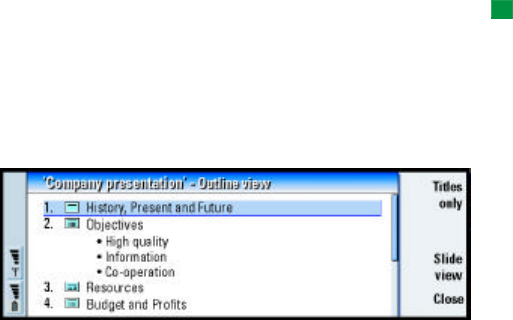
245
Office
View a presentation
Press Open in the Presentation main view to select and view a document. To close
the application, press Close.
Tip: You can zoom in and
out to get a better view of
the presentation.
When a document is opened, the top of the first slide is shown. To view the next
slide, press Next or Enter. To view the previous slide, press Previous. To scroll the
current slide, use the Arrows key.
Outline view
To get an overview of the whole presentation, press Outline view. This opens up a
view where the text content of the presentation is in a list format. See Figure 91.
Figure 91
To view only title texts, press Titles only. To return to the standard slide show,
press Slide view.
Search for and view a slide
1Press the Menu key and select Tools > Go to slide…. A list of the slides in the
presentation opens.
2Go to the slide you want by using the Arrows key.
3Press Go to open the slide.
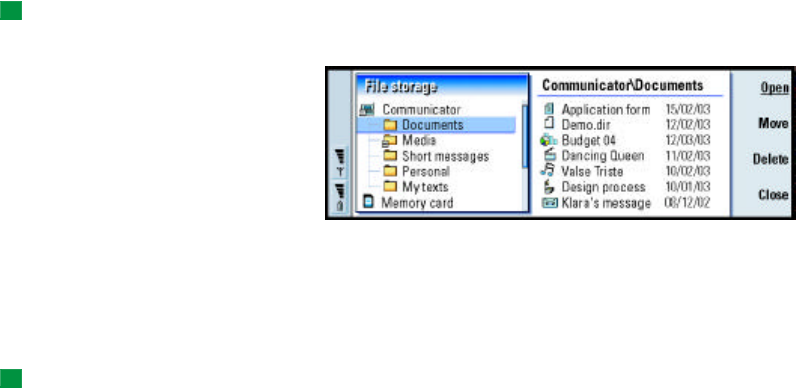
246
Office
View the presenter’s notes
To view the presenter’s notes along with the slides, press the Menu key and select
View > Notes view.
File manager
Tip: Use File manager
together with a memory
card to remove files and
folders from the
communicator memory and
thus free memory. See ‘Back
up and restore data to and
from the memory card’ on
page 251.
You can use File manager to manage the contents and properties of various folders.
The main view has two frames: a folder tree on the left and a file list on the right.
Figure 92
You can toggle between the frames with the Tab key.
Folder view
The folder tree can contain folders from two roots, the communicator and a
memory card.
Tip: Avoid saving files to
the root of the
communicator; use folders
instead.
Under the communicator root there is C:\Documents\ folder that contains four
default folders: \Documents\Downloaded\, \Documents\Photo gallery\,
\Documents\Templates\, and \Documents\Tones\.

247
Office
To show or hide subfolders in the folder list frame, press < and > on the Arrows
key. The - and + signs in front of the folder icons indicatewhether the subfolders
are shown or hidden. Folders without either sign have no subfolders, and you can
use the Arrows key to switch between the folder view and files view.
Note: Multi-selection is not possible in the folder list frame.
Files view
Tip: To change the
sorting order or the value by
which the files are sorted
(name, date and time, type,
and size), press the Menu
key and select View > Sort by
or Sorting order.
The file list on the right shows all the files in the source or folder currently selected
in the left frame. The title of the file list frame shows the path of the currently
selected file. The file list frame also shows the application-related icon, name, and
the last modification date of the file.
The files are sorted in alphabetical order by default.
Note: Hidden files are shown only if you press the Menu key and select View >
Show all files.
View the contents of a folder
1Choose a folder in the left folder tree frame and press Open.
A view of all the subfolders and files of the parent folder opens. See Figure 93.
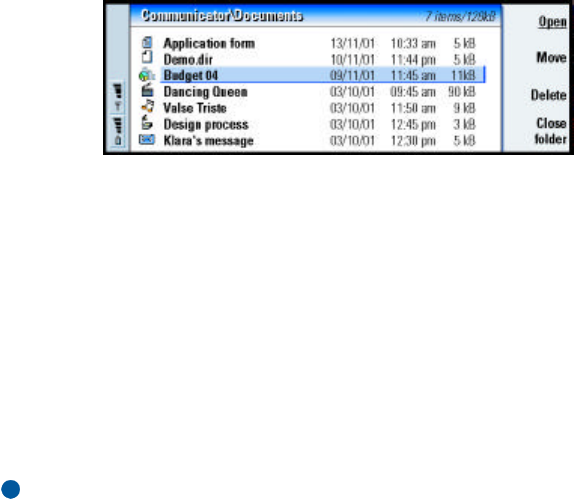
248
Office
Figure 93
2To view any possible subfolder, select it and press Open.
3To view parent folders, press Esc.
4Press Close folder to return to the main view.
The title of the folder content view shows the path name and the number of files
and subfolders in the folder, together with the total size of all the files in the
folder.
This view shows the name, last modification date and time, and the size of a
particular file. The icon in front of the name indicates the type of file or subfolder.
Open a file
1Select a file and press Open. The file will then be opened in the corresponding
application.
2To return to the main view, press Close folder.
Note: You can open only one file at a time.
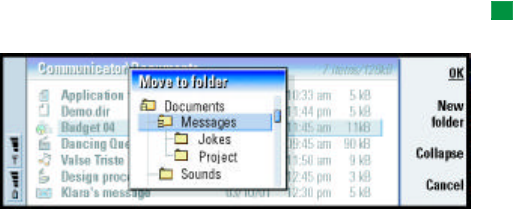
249
Office
Moving files and folders
Tip: For multi-selection,
see ‘Select several items at
once’ on page 72.
1Select folders or files that you want to move and press Move in the main view
of File manager. A list of folders opens, as shown in Figure 94.
Figure 94
2Search for a target folder with the Arrows key.
To hide or show the subfolders of a folder, press Collapse and Expand
respectively. You can also navigate in the folder list with the Arrows key and +/
- keys.
To create a new target folder, press New folder.
3Press OK to confirm the move and Cancel to dismiss it.
Create new folders
1In the main view of File manager select the folder in which you want create a
new folder
2Select File > New folder.
3Name the new folder.
4To confirm the changes, press OK. To dismiss the changes, press Cancel.

250
Office
Rename files and folders
1Select the file or folder in the main view of File manager.
2Press the Menu key and select File > Rename. The cursor now appears at the
beginning of the selected file or folder name.
3Rename the file or folder.
4To confirm the changes, press OK. To dismiss the changes, press Cancel.
View the properties of files, folders, and drives
Tip: In the Properties
dialog, you can also change
a file into hidden or read-
only state or a folder into
read-only state.
1Select the file, folder, or drive in the main view of File manager.
2Press the Menu key and select File > Properties…. A dialog opens, as shown in
Figure 95.
Figure 95
Search for files and folders
1Choose the folder or memory storage where you want the search to take place.
2Press the Menu key and select Tools > Find…. A dialog opens.
3Enter in the field the string for which you want to search.
4Press Options to define the search in more detail. See Figure 96.
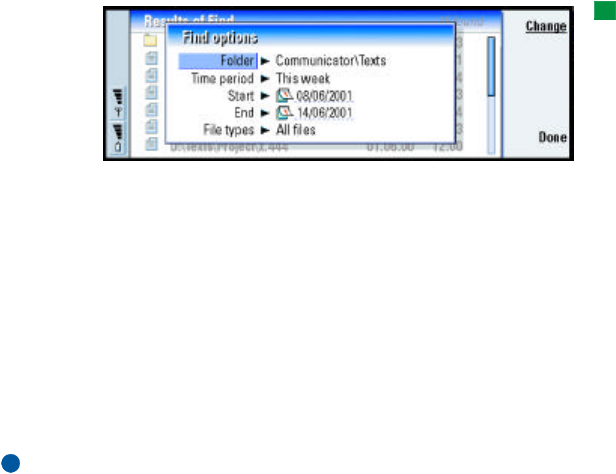
251
Office
Tip: You can search
according to time period,
start and end time, and the
file type.
Figure 96
Press Change to change the value of a list item.
When ready, press Close.
5Press Find to start the search.
To interrupt the search, press Stop.
6When the search is over, press Open to open the folder or file found.
To start a new search, press New find.
7To return to the main view, press Close.
Back up and restore data to and from the memory
card
It is advisable to make backups of your communicator data regularly.
Note: The Backup and Restore commands will copy all data. You cannot back
up or restore an individual folder. The Backup and Restore commands are
recursive; that is, they copy folders and all the contents within the
folders. For information about selective backups, selective restoring, and
using PC to back up and restore, see the PC Suite guide on the sales
package CD-ROM.
252
Office
To be able to back up to and restore from a memory card, the card should be
inserted in the communicator. For details, see ‘Inserting the memory card’ on page
71.
1Press the Menu key and select Memory card > Backup to memory card… or Restore
from memory card…, depending on what you want to do. A dialog opens.
2If you are making a backup, look for a backup folder on the memory card by
pressing Change or type in the name of a new folder in the Backup folder field.
If you are restoring data to your communicator, select the folder in the
communicator into which you want to restore your data. Normally you should
select the root folder.
3Press Backup to back up all the communicator data to the memory card.
Press Restore to restore all the backed-up memory card data to the
communicator.
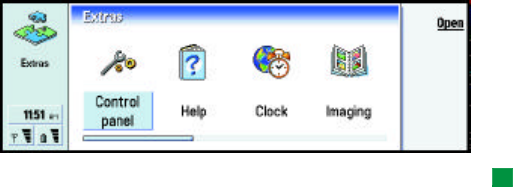
253
Extras
12. Extras
Extras contains the following applications: Calculator, Clock, Control panel,
Recorder, Imaging, Cell broadcast, Video player, and Fax modem.
Most of the new applications that you install will be added to the Extras
application group. For more information on applications available on the sales
package CD-ROM, see Software on CD-ROM Guide in the Using Nokia 9290
Communicator section of the CD-ROM.
Figure 97
Tip: To install
applications, see section
‘Install/Remove software’ on
page 264.
Clock
The Clock shows the time and date in your home city and country or region, as well
as in several other cities and countries in the world. The Clock also includes an
alarm clock.
To set the current date and time for your communicator, press the Menu key and
select Tools > Date and time….
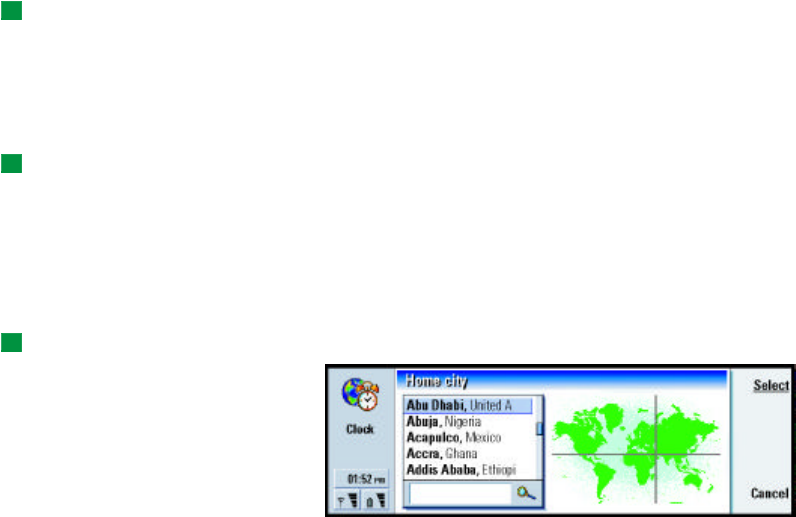
254
Extras
Tip: To choose the clock
type, press the Menu key
and select View > Clock type
> Digital or Analog.
Set an alarm
1Press Alarm clock in the main view. An alarm clock view opens.
2The currently active alarms are listed next to the clock.
3To create a new alarm, press New alarm or to edit an alarm, press Edit alarm.
4Define the Time of the alarm and the frequency in Occurrence and Day fields.
Define also the Description displayed when the alarm goes off.
Tip: To turn off a
sounding alarm, press Stop
or any key on the keypad of
the phone cover. Press
Snooze to silence the alarm
for five minutes.
5Press Done to accept the set alarm.
Change your home city
If your home city and time settings on your communicator are not set correctly,
you must first set your home city and then set the time, since your home location
defines the time zone used.
1Go to the World clock main view.
Tip: The world map
shows the currently selected
city in cross hairs.
2Press Change city. A cities view opens. See figure 98.
Figure 98
3Type the city in the search field or scroll the list and press Select when ready.
4Press OK to accept the change of time zone or Cancel to dismiss it.
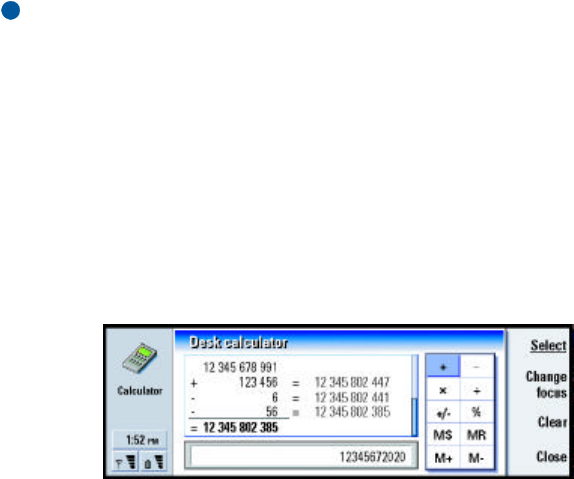
255
Extras
Note: For more detailed information about Clock, see the Nokia 9290
Communicator help.
Calculator
There are two modes in Calculator: desk calculator for simple arithmetic
operations and scientific calculator for more complicated mathematical
calculations.
There are two ways to perform calculations, either by typing the characters in the
input field or selecting symbols from the function map. A calculation is executed
by pressing Enter or =.
The calculation and its result can be seen on the output sheet on the left. You
cannot write in the output sheet, but selection is possible.
Figure 99
To move between the input field, output sheet, and function map, press the Tab
key.
The input field is never empty in the desktop calculator: it contains either the result
of the previous calculation or a zero (0) if you have pressed backspace.
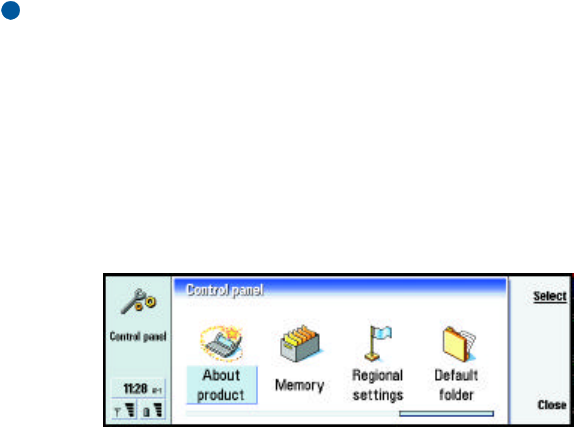
256
Extras
Note: For more detailed information about Calculator, see the Nokia 9290
Communicator help.
Control panel
In the Control panel you can view or modify the following: Security, Data call
restrictions, Data call restrictions, Profiles, Data call restrictions, Certificate manager,
Date and time, Install/Remove software, Internet access, About product, Memory,
Regional settings, and Default folder
Modifying these features affects the operation of your communicator across all
the applications.
Figure 100
To open a program for editing, select it with the Arrows key and press Select.
Security
Here you can define the phone security level of your communicator.

257
Extras
IMPORTANT: The default lock code is 12345. For security reasons, it is
imperative that you change the lock code. Keep the code secret and in a
safe place, separate from the communicator.
The codes are shown as asterisks. If you are changing a code, you will be prompted
for the current code and then the new code twice.
PIN code request:
If you set the PIN code request On, the communicator requests that you
enter the code every time you turn on the phone. If you enter the PIN code
incorrectly three times in succession, you will need a PUK code to unblock
the SIM card. When the SIM card is blocked, you cannot send or receive
any documents or calls except calls to preprogramed emergency numbers.
Otherwise, the communicator can be used normally. You need the PIN
code to change this setting.
Note: This setting cannot be changed, if the phone is switched off or if there is
no valid SIM card inserted.
Note: Some SIM cards do not allow you to turn the PIN code request off.
Autolock period:
Determines the security time-out period, after which the communicator
will lock. The options are None/2 minutes/5 minutes/10 minutes. The last
option allows you to define the number of minutes yourself. When the
communicator is locked, you can make emergency calls to predefined
numbers using the cover phone. You can also answer incoming calls and
make emergency calls using the Telephone application. All other actions
are blocked. The timer is reset by any input, data transfer, printing, and so
on. You need the lock code to change this setting.

258
Extras
Lock if SIM card is changed:
If set On, every time the phone is switched on this security option checks
whether the SIM card in the communicator has been changed. If the SIM
card has been changed and the new SIM card has not been used with your
communicator previously, the communicator locks itself until the lock
code is correctly entered. The communicator recognizes five different SIM
cards as the owner’s cards. You need the lock code to change this setting.
Tip: Changing the PIN
code requires that PIN code
request is selected, the
phone is on, and that there
is a valid SIM card inserted.
PIN code:
This setting allows you to change the PIN code. The new PIN code must
be from 4 to 8 digits long.
PIN2 code:
This setting allows you to change the PIN2 code. The PIN2 code is required
to access some functions, such as the call cost settings, which must be
supported by your SIM card. If you enter an incorrect PIN2 code three
times in succession, you will need a PUK2 code to unblock the PIN2 code.
The new PIN2 code must be from 4 to 8 digits long.
Lock code:
This setting allows you to change the lock code. The default lock code is
12345. The new lock code must be from 5 to 10 digits long. If you enter
an incorrect lock code five times in succession, the phone will be locked
for five minutes after which you can try again. If you try again within less
than five minutes, you have to wait five minutes more before a code can
be accepted.

259
Extras
Tip: Changing the
restriction password
requires that the phone is on
and the Call restriction
service is activated for your
SIM card.
Restriction password:
This setting allows you to change the restriction password. If you enter an
incorrect password three times in succession, the password is blocked and
you must ask the system service provider for a new password.
Note: Avoid using codes that are similar to emergency numbers to prevent
accidental dialing of the emergency number.
Note: Even when the communicator is locked, it is possible to call to the
emergency number preprogramed into the phone (for example, 911 or
other official emergency number).
Data call restrictions
Tip: Use data call
restrictions to limit the use
of the phone, if you borrow
it to someone temporarily.
Here you can prevent or allow the following data call types:
Note: You need a restriction password to modify these settings.
Outgoing calls: When activated, prohibits making data calls.
Incoming calls: When activated, prohibits receiving data calls.
International calls: When activated, prohibits making international calls.
Tip: To check the current
status of a restriction
option, select the option and
press Check status.
Incoming calls when roaming: When activated, prohibits receiving calls when
roaming.
International except to home country: When activated, prohibits making
international calls to all countries except to the country that has been
defined as the home country.
Note: Calls described here as international may in some cases be made between
regions of the same nation.
260
Extras
Accessories
Here you can define some of the settings when you use the Nokia 9290
Communicator with Advanced HF Car Kit CARK109 or Headset HDC-8L.
For other information on accessories for Nokia 9290 Communicator, see the
accessories section of this guide.
Define the accessories options as follows:
1Double-click the Accessories icon in the Control Panel. A dialog opens
2Select the accessory options that you want to modify. The options are Headset/
Car kit. Press Edit.
3Define the following:
Headset settings
Automatic answer: Allows you to define whether the automatic answering is on or
off when your communicator is attached to the car kit.
Default profile: Allows you to choose the profile that will be automatically selected,
when you attach your communicator to the car kit.
Car kit settings
Cover display lights: Allows you to define whether the cover display lights are always
on or not when the headset is attached to your communicator.
Automatic answer: Allows you to define whether the automatic answering is on or
off when the headset is attached to your communicator.
Default profile: Allows you to choose the profile that will be automatically selected,
when the headset is attached to your communicator.

261
Extras
Profiles
Here you can edit profiles. Profiles define the tones and sound level of your
communicator in different operating environments.
For details on profiles, see ‘Profile settings’ on page 120.
Display
Here you define the appearance of the display.
Contrast page
Figure 101
Press + and - to adjust the bar you are editing.
Contrast level: Pressing + increases and - decreases the contrast of the display.
Brightness: The brightness level of the display. There are five levels to choose from.
Screen saver: A time period after which, if there has not been any key presses within
that time, the brightness will go down to its lowest level. The level will rise
to the level defined in Brightness as soon as any key is pressed again. The
options are 15 sec/30 sec/45 sec/1 min/2 min.

262
Extras
Tip: Selecting a low
brightness level and a short
time period for the last two
options saves the battery
and increases the operation
time of the communicator.
Brightness period: A time period after which the display will blank out if the device
remains inactive. The options are 2 min/4 min/6 min/8 min/10 min.
Colors page
Color palette: The display color scheme. The options are Blue/Red/Green/Grey.
Background pattern: The background image of the command button area. The op-
tions are Plain/Wheels/Sand/Water/Leaves.
Certificate manager
With Certificate manager you can manage digital certificates which you use when
connecting to WWW sites, WAP services, mail servers, and when installing
software. You need these certificates when you:
•want to connect to an online bank or some other site or remote server for
actions that involve transferring confidential information,
•want to minimize the risk of viruses or other malicous software and be sure of
the authenticity of software when downloading and installing it.
Note however, that even if the use of certificates makes the risks involved in
remote connections and software installation considerably smaller, they must be
used correctly in order to benefit from increased security. The existence of a
certificate does not offer any protection by itself; Certificate manager must
contain correct, authentic, and trusted certificates for increased security to be
available.
To open the main view of Certificate manager, press the Extras application button,
select Control panel, and select Certificate manager.

263
Extras
The main view lists the currently available certificates and their validity
information.
Note: Certificates have a restricted lifetime. If a certificate is marked Expired
even if it should be Valid, check that the date and time in your
communicator are correct.
Define the usage of the certificate
1Select the certificate and press View details. A dialog with certificate details
opens.
2Press Trust settings. A dialog opens.
3If you want this certificate to be able to certify WWW sites and mail servers,
select Web browser and Mail, press Change, and select Yes
4If you want this certificate to be able to certify the origin of a new software,
select Software installation, press Change, and select Yes.
Note: Before changing these settings, you must make sure that you really trust
the owner of the certificate and that the certificate really belongs to the
listed owner.
Check that a certificate is authentic
Certificates are used to verify the origin of WWW pages and installed software.
However, they can only be trusted if the origin of the certificate is known to be
authentic. If you are adding a new certificate, or want to check the authenticity of
an existing certificate, proceed as follows:
1Select the certificate and press View details. A view of certificate details opens.
2The Subject: field identifies the owner of this certificate. Make sure that this is
the name of the party to whom you think that this certificate belongs.
3Scroll the dialog until you see the Fingerprint: field.

264
Extras
4The Fingerprint: field uniquely identifies the certificate. Contact the help desk or
customer service of the owner of the certificate (see step 2 above) and ask for
the MD5 fingerprint of the certificate. Compare the fingerprint with the one
shown in the dialog. If they match, the certificate is authentic.
Note: Use this authentication procedure each time you add a new certificate.
Add or delete certificates
To add a new certificate, press Add. A dialog opens in which you can search and
select the new certificate.
To delete a certificate, select it and press Delete.
Date and time
Here you define the current time and date for your communicator.
Time: The current time.
Date: The current date.
Daylight-saving: Determines how the time of your communicator is affected by
changes in daylight saving time. The options are On/Off/Define summer. If
Define summer is selected, you have to enter the dates Summer starts and
Summer ends.
Install/Remove software
With Install/Remove you can install new software or remove installed applications
from your communicator.

265
Extras
When you open the Install/Remove application, the Installed software page lists all
of the software packages that have been installed, with their name, version
number, type, and size.
Press Certificate Info to display the certificate details of an installed software
package that has a digital signature and a certificate.
Install software
The types of applications which you can install are those that are specifically
intended for the Nokia 9290 Communicator or suitable for the Symbian operating
system on Crystal style devices, and Java applications.
Note: If you install software that is not intended specifically for the Nokia 9290
Communicator, its usage can differ significantly from the usual Nokia
9290 Communicator applications.
You can download or transfer a software package containing the files of the
application into the communicator. Then you can install the application. Software
can also be installed from a memory card. A software package is usually one large
compressed file containing many component files.
Tip: You can also start
the installation by browsing
for the installation package
in communicator memory or
memory card with File
manager, selecting it, and
pressing the Enter key.
IMPORTANT: When downloading or transferring software packages into the
communicator, use only packages whose file names end ‘.sis’. An
example suitable file name is ‘MediaPlayer.sis’.
To start the installation, press Install new on the Installed software page. Browse for
the software package you want to install, and press OK. The installation process
begins.
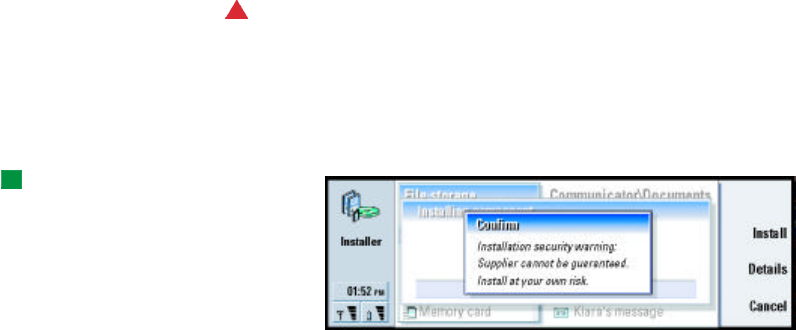
266
Extras
WARNING! Only install software from sources that offer adequate protection
against viruses and other harmful software. To help you, the
software installation system on the Nokia 9290 Communicator
uses digital signatures and certificates on software packages. See
page 264.
If you are installing software without a digital signature or a certificate, the
communicator warns you of the risks of installing software, as shown in figure 102.
Tip: If you have installed
PC Suite for Nokia 9290
Communicator on your PC
and the communicator is
connected to your PC, you
can also install software by
double-clicking a file ending
with .sis stored on your PC. Figure 102
If you see this warning message, only continue installation if you are absolutely
sure of the origin and contents of the software package.
The installation procedure also checks the integrity of the package to be installed.
Once these checks are complete, the application is installed on your
communicator. During the installation process, you are shown information about
the checks being carried out on the package. You are also given options whether
to continue with or cancel the installation.

267
Extras
Remove software
1To remove an installed software package from your communicator, select the
software package you want to remove from the Installed software page and
press Remove.
2A dialog appears asking for your confirmation. Press OK to remove the
software.
Note: Some software packages update existing software and cannot be
removed.
IMPORTANT: If you remove software, you can only re-install it by having the
original software package file, or by restoring a full back-up that
contains the removed software package. If you remove a software
package, you may no longer be able to open documents created with that
software. If an another software package depends on the software
package that you removed, the other software package may stop
working. Refer to the documentation of the installed software package
for details.
Installation log
To view the list of software installations and removals that have taken place, press
the Menu key and go to the Install log page. This list shows what software has been
installed and removed, and when that happened. If you encounter problems with
the device after installing a software package, you can use this list to find out
which software package may be the cause of the problem. The information on this
list may also help to pinpoint problems that are caused by software packages that
are incompatible with each other.

268
Extras
Installation settings
On the Preferences page, you can select options related to software installation.
You can define the following:
Delete installation file after use - If set to Yes, the software package installation file
(that ends in.sis) will be deleted from the device after installation. If you download
software packages using the WWW browser, this may be helpful in reducing the
amount of required storage space.
Note: If you want to store the software package file for possible re-installation
later on, either set this to No or make sure that you have a copy of the
software package file stored on your PC or on a CD-ROM.
Default installation language - You can set the default installation language to the
language that your Nokia 9290 Communicator has. If the software package
contains several different language versions of the software, the language version
specified here will be installed.
Sort installed software by - To sort the list of installed software packages, select one
of the options Name, Type, or Size.
Internet access
Here you are able to edit, create new, and delete existing Internet access points.
For details on how this is done, see the Internet section of the Settings checklist
delivered in your sales package. For details on IAPs, see ‘Setting up your Internet
access point’ on page 173.

269
Extras
About this product
Here you can scroll to see copyright information on the Nokia 9290 Communicator.
Memory
Here you can view the amount of free memory for storing data and installing new
software. You can scroll and view the memory consumption of the following
details: Documents, Spreadsheets, Sounds, Faxes, Mails, Short messages, Calendar data ,
Contacts, Images, Installed applications, and Other file types.
If your memory card is inserted in the communicator, press Memory card to view
the amount of available memory on the card. Press Device to return to view the
communicator memory.
If the memory is getting low, you should remove some documents. Before
removing, you can print, fax, or mail them, or transfer them to a PC or a memory
card.
Regional settings
On these four pages you can define the local time, date, numbering, and currency
expressions.
Note: For more detailed information about Regional settings, see the Nokia
9290 Communicator help.
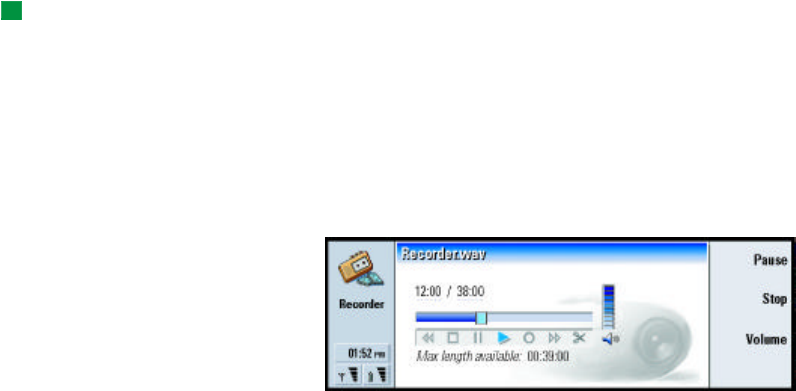
270
Extras
Default folder
With the Default folder, you can define the folder which acts as a default saving
folder whenever you wish to save a document in your communicator memory. For
details on how to manage your files and folders, see ‘File manager’ on page 246.
Recorder
Tip: When you have
recorded sounds and speech,
you can set them as ringing
tones. See page 140.
The Recorder allows you to record telephone conversations and voice memos. You
can also listen to your recordings and other sound files.
The maximum length of a recording depends on the available memory.
You can open files that have been stored in the following file formats: .WAV, .AU,
and compressed GSM encoded file format. Compression is done implicitly during
the recording process.
Recorder contains all the controls like Play, Stop, Pause, and Record that are
typically found in recording equipment. Press Resume to continue after recording
or playback has been paused.
Figure 103

271
Extras
You can change the volume level of the Recorder application by pressing the ∧ and
∨ keys on the Arrows key. You can also edit sound files by using the commands in
the Edit menu.
WARNING! Obey all local laws governing recording of calls. In some states it
is unlawful to record a phone conversation without first advising
all call participants.
Note: For more detailed information about Voice recorder, see the Nokia 9290
Communicator help.
Imaging
The Imaging application acts as a file manager for images. Application folders
created for storing images are called albums. Images appear as thumbnail images
in albums. A thumbnail image is a small image representing the original full size
image.
Imaging supports a wide range of image formats, among them JPEG, TIFF, GIF,
BMP, MBM, and WBMP.
Tip: Press the Menu key
and select View > Zoom >
Zoom ratio… to zoom by
exact figures.
You can open all commonly used image files directly for viewing. Press Zoom in to
enlarge the image, Zoom out to reduce the image on the display, and Rotate to
rotate the image.
To view image properties, press the Menu key and select File > Properties…
You can use the Imaging application for viewing images and handling image
albums.
You can delete, rename, copy, and move images from one album to another and
create your own favorite albums.
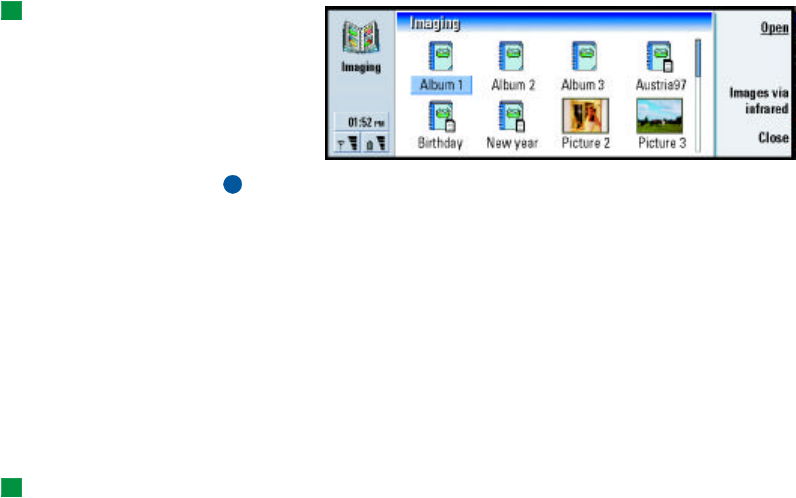
272
Extras
Tip: If you have images or
albums in the
\Documents\Photo gallery\
directory on an inserted
memory card, they also will
appear in this view.
Figure 104
Note: Albums can contain only images, not subalbums.
You can also receive images via IR. For details, see ‘Receive images via infrared’ on
page 274.
Create a new album
1Press the Menu key and select File > New album…. A dialog opens.
2Define the following:
Name: Name of the album.
3To save the album in the communicator, press Create locally.
To save the album in the memory card, press Create in mem. card.
View album contents
Tip: To open an image
located outside the image
albums, select File > Open
from….
1Select the album in the Imaging main view and press Open. A thumbnail view
of the album contents opens.
2You can scroll the contents of the album with the Arrows key.
To open an image for viewing, press Open.
3To view the next frame in the image, if available, press the Menu key and select
View > Next frame. To return to the previous image, select Previous frame.

273
Extras
4Press Close to return to the thumbnail view.
Move images to and from albums
1Select the image or images in the thumbnail view with the Arrows key.
Tip: You can select
several images with the
Space key. You can also use
the Edit menu commands
and the corresponding
shortcuts (Ctrl+c, Ctrl+x,
Ctrl+v) to move or copy
images.
2Press the Menu key and first select Edit > Copy or Cut.
3Press Close album.
4Open the target album.
5Press the Menu key and select Edit > Paste.
6If the target album already has an image or images with the same name, a
confirmation note appears asking you if you wish to replace the existing image.
Choose from the following options:
Replace - The existing image is replaced with the image you are pasting.
Replace all - All existing images are replaced with the same name.
Skip - Skips the image and continues the operation.
Cancel - Cancels the whole paste operation.
Tip: To rename albums or
images, select File >
Rename…., define a name,
and press OK. The file
extension cannot be
changed.
Create new images from originals
You can choose parts of an opened image, save them as separate images, and reuse
them.
1Open an image. Press the Menu key and select Edit > Select image range. The
selection frame is now visible on the image.
2To move the selection frame, use the Arrows key.
To change the size of the selection frame, press down the Ctrl key and use the
Arrows key.

274
Extras
3To save the frame as an image, press the Menu key and select File > Save as….
Select Selected range.
4Select the folder you wish to save in, give a name for the new image file, and
press OK.
Resize images
1Press the Menu key and select Tools > Resize…. A dialog opens.
2Scroll with the Arrows key to select the new size and press Select or press Best
fit to fit the image horizontally to the screen.
Receive images via infrared
Tip: Large images
transferred from a digital
camera may take too much
internal memory to be
viewed. To scale the size of
the transferred images
down to 640x480 pixels,
press the Menu key and
select Tools> Use VGA, if the
option is not already
selected. Note that all
cameras may not support
this function.
1Open the album where you want to save the received file.
2Press Images via infrared. A dialog opens.
3Select one of the following:
Receive in album: To receive the image and save it.
Receive and mail: To receive the image and send it as an e-mail message.
Receive and fax: To receive the image and send it as a fax.
4Press OK.
Video player
Video player shows video clips of files in ‘Nokia Interleaved Multimedia’ (NIM)
format. You can open these files from the File manager or other applications in the
communicator, or download and play them from your Web browser.
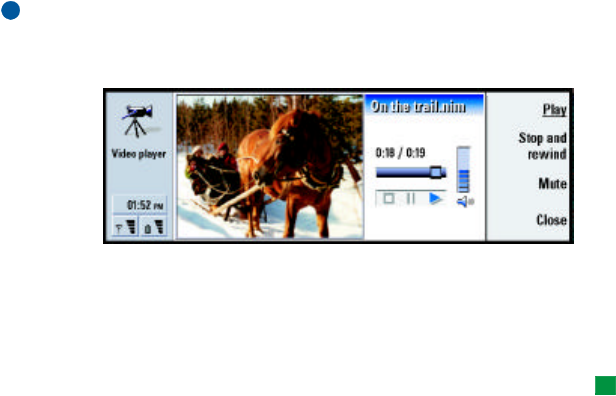
275
Extras
You can find NIM format files on the CD-ROM in the sales package. Alternatively,
to convert a common video file format such as AVI to NIM format, use the
Multimedia converter application. You can find this application on the CD-ROM.
For more information on installing files from the CD-ROM, see page 81.
IMPORTANT: Video player is pre-installed on the memory card contained in the
sales package. It will not work if you remove the memory card.
The main view of Video player is shown in figure 105.
Figure 105
It shows indicators for play, pause, and stop. The elapsed time and total time are
shown as digits.
Cell broadcast
Tip: Check with your
system service provider to
see whether CBS is
available.
Cell Broadcast is an application which you use with the Cell Broadcast Service
(CBS) to view the messages and to subscribe to topics of interest. In areas where
CBS is provided, you can receive short messages on various topics such as taxis,
weather, service provider services, and directory enquiries.
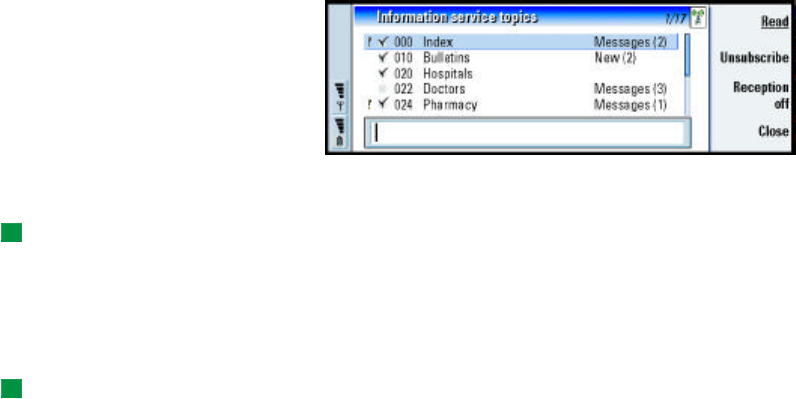
276
Extras
Figure 106
To start or stop receiving CBS messages, in the main view of Cell broadcast, press
Reception on or Reception off.
Tip: You can search for
different topics. Enter a
name of a topic in the
search field.
Press Read to read messages and press Next or use the commands in the View
menu to browse for more messages.
To subscribe, scroll to a topic and press Subscribe. A check mark is displayed in the
box on the left-hand end of the topic. To unsubscribe, press Unsubscribe.
To add, edit, or remove topics when the reception is off, press the Menu key and
select > Topic > Add topic/Edit topic/Delete topic(s).
Tip: You can quickly mark
a topic as a hot topic by first
selecting the topic and then
pressing Ctrl + M.
If you want to be notified with a dialog displaying a message on a particular topic
when a new topic message is received, press the Menu key and select Topic > Mark
as hot topic. The hot topic is marked with an exclamation mark “!”.
Create or rename topic lists
To create a new list, press the Menu key and select List > New blank list… or New list
with selected topics…

277
Extras
Tip: You can sort the
topics by pressing the Menu
key and selecting a sorting
command in the View menu.
To change the name of the list that is open, press the Menu key and select List >
Rename list…
Note that the reception must be turned off.
Open topic lists
To open a different list, press the Menu key and select List > Select topic list.
In different topic lists, you can still subscribe and unsubscribe topics and set them
as hot topics.
Detect new topics
To add new topics automatically, press the Menu key and select Tools > Settings….
Define the following:
Tip: Create a new empty
topic list and select the Yes
and All options in the
settings to receive a
complete list of topics
available in that area.
Add new topics to list - The options are Yes/No. If you select Yes, all new topics are
added automatically to your current list of topics. If you select No, you will receive
only the messages concerning subscribed or hot topics that you already have in
your topic list.
Language - Select the language of the topics you want to receive. Select All to
receive topic messages in all languages.
Note: You will receive only the messages that are in the language you have
chosen. To make sure you receive all messages, select All.

278
Extras
Fax modem
You can use the communicator as a fax modem with a compatible PC. Your
communicator can be connected to a PC via serial cable or by using an infrared
connection.
Before your PC can recognize the communicator as a fax modem, you need to
install a new modem configuration for your PC. Please refer to your operating
system manual for more information. During the installation you may be asked to
enter the path to the modem information file. The path on the sales package CD-
ROM is: \ Software for PC \ Printer and Modem drivers. Advanced users can also
find a list of supported AT commands from this path. Normally there is no need to
use these commands.
Note: Using the communicator as a fax modem requires that data calls are
supported by the service provider and that this service is active in your
SIM card.
Install fax modem driver using cable connection
1Start Windows.
2Insert the Nokia 9290 CD-ROM into the CD-ROM drive of the computer and
locate the modem information file (mdmn9290.INF). Alternatively, you can find
the file on the www.forum.nokia.com Web site.
3Double-click the Modems icon in the Windows Control Panel. A dialog opens. If
no modem drivers have been installed on the computer before, continue from
step 6.
4Click the Add button.
5In the field What type of modem do you want to install? select Other. Click Next

279
Extras
6Select the option Don’t detect my modem; I will select it from a list
7Click Have disk...
8Click Browse and locate the CD-ROM drive with the Nokia 9290 CD-ROM.
9On the CD-ROM, locate a folder Software for PC/Modem drivers
10 In the Modem drivers folder, select Mdmn9290.inf file and click Open or OK.
Tip: To use High Speed
connection, your GSM
operator must activate High
Speed Data Services on your
SIM card.
11 In the Install from disk dialog, Click OK.
12 In the Install New Modem dialog, select Nokia 9290 Communicator (Cable). If you
are using High Speed connection (HSCSD), select a speed higher than 9600 bps
and cable connection. Click Next.
13 Select the COM port where the serial cable is connected. Click Next.
14 Click Finish.
15 Remove the CD-ROM from the drive.
16 In your communicator, press the Extras application button, select Fax modem,
and press Open.
17 In the Fax modem application, press Settings
18 On the Connection page of the Fax modem settings, define the following:
Connection type: Cable
Transfer rate: 19200 or higher. Make sure that this setting is the same both in
your communicator and your PC.
Data bits: 8
Stop bits: 1
Flow control: Software
Press Done.
Note: Transfer rate is the speed with which the data is transferred between
your communicator and PC. The best transfer rate for normal GSM calls
is 19200 or higher. For high speed calls, you should select 115200. Select
the same rate in your PC application as well.

280
Extras
19 Your communicator is now ready to be used as a fax modem. Press Activate to
activate the Fax modem.
Fax modem settings
To open Fax modem, press the Extras application button, select Fax modem, and
press Open
Note that an active PC connection using the fax modem is disconnected after 20
minutes if no data is sent or received. However, an active call is not automatically
disconnected.
Note: You cannot change fax modem settings if the fax modem is activated. To
change these settings, make sure that fax modem is not active.
Open Fax modem and press Settings. A dialog with two pages opens.
Define the following:
Connection page
Connection type: Press Change to change this option. The options are Infrared and
Cable. If you select Infrared, the rest of the options are automatically set.
If you select Cable, define also the following:
Transfer rate: The speed with which the data is transferred between your commu-
nicator and PC. The best transfer rate for normal GSM calls is 19200. For
high speed calls, you should select 115200. Select the same rate in your
PC application as well.
Data bits: Defines how many bits are used to form a byte. The default option, 8, can
typically be used.

281
Extras
Parity: A parity error-checking procedure. The default option, None, can typically
be used.
Stop bits: Defines number of stop bits used. The default option, 1, can typically be
used.
Flow control: It is recommended to select Software. This setting needs to be the
same in you PC as well.
Operating system page
Windows 2000: If you are not using Windows 2000, press Done and select No. The
rest of the options on the page are dimmed. If you are using Windows
2000, select Yes. Define also the following information about the connec-
tion. The information needed is provided by the host that you are about to
call. If you do not have this information try to use the default options.
Connection type: The options are Normal/High speed. Normal is the default.
Remote modem type: The options are Analog/ISDN V.110/ISDN V.120Analog is the de-
fault.
Max. connection speed: The default in an analog connection is Automatic.
Note: This configuration needs to be redefined if you use a different kind of
modem. If the connection settings are incorrect, the call is not created.
Activate or disable the fax modem
In the Fax modem main view, press Activate or Disable.
282
Extras
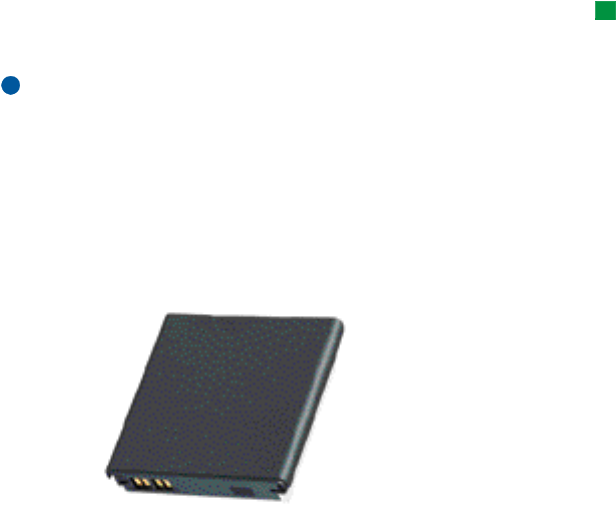
283
Accessories guide
13. Accessories guide
Tip: Original Nokia
accessories cover a wide
range of user environments:
advanced data transmission
equipment, practical
headsets, chargers and
holders for mobile as well as
office use.
Original Nokia accessories ensure the best possible operation of your Nokia mobile
phone in various conditions. The Nokia 9290 Communicator accessories have been
designed for different users and communication needs.
Note: Use only batteries, chargers, and accessories approved by the
communicator manufacturer for use with this particular communicator
model. The use of any other types will invalidate any approval or
warranty applying to the communicator, and may be dangerous.
Power management
High power battery BLL-3
Figure 107
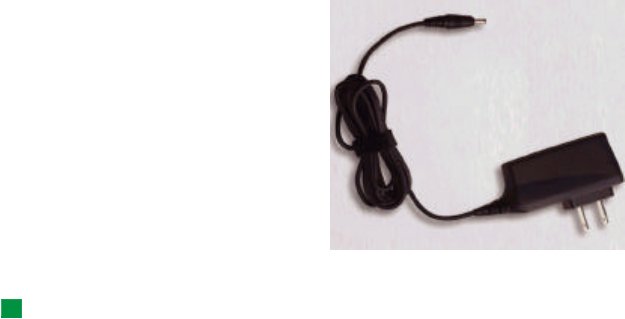
284
Accessories guide
The High Power Battery BLL-3 is a slim, powerful and durable 1300 mAh Li-Ion
battery. This battery provides you with a talk-time of 4-10 hours and stand-by
time of 80-230 hours, depending on usage.
The combined weight of the Nokia 9290 Communicator with battery is 244 g,
(approximately half a pound).
Performance travel charger ACP-12U
Figure 108
Tip: This charger is
especially suitable for active
travellers.
The Performance Travel Charger ACP-12U is a lightweight and durable charger
which functions over most mains voltages. The communicator can be operated
normally during charging. Using this charger, the charging time of the
communicator is approximately 180 minutes (depending on the amount of charge
already in the battery).
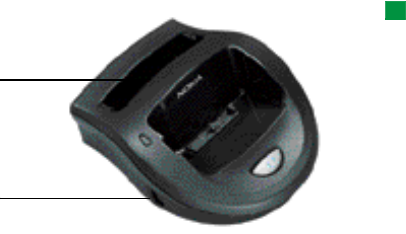
285
Accessories guide
Advanced desktop stand DCH-10
Tip: To charge batteries
with this stand you need the
Performance Travel Charger
ACP-12U. To connect to a
PC, you need the RS-232
Adapter Cable DLR-2L. You
can also connect to a PC via
infrared.
Figure 109
The Advanced Desktop Stand DCH-10 provides a convenient way to
•charge the battery when it is attached to the communicator
•connect to a compatible PC for data transfer.
It has an infrared port on the left side of the stand; see Figure 109. The stand also
has a slot for charging batteries separately from the communicator; this is
especially convenient for charging spare batteries.
Charge the communicator battery with the desktop stand
1Plug the Performance Travel Charger ACP-12U into the stand.
2Place the communicator, with the battery attached, in the desktop stand
connector end first.
3Plug the charger into a mains outlet.
charging slot for
spare battery
infrared port

286
Accessories guide
Charge a spare battery with the desktop stand
1Plug the Performance Travel Charger into the stand.
2Insert the spare battery in the second slot, the golden contacts first. First press
the battery downwards, then push it slightly backwards, until it clicks into
place.
3Plug the charger into a mains outlet. Check that the light on the left of the
stand is on. The red light indicates that charging is in progress. When the
battery is charged you will see a steady green light.
4To remove the battery, slide it forwards then lift it up and out of the stand.
Note: If the communicator is also charging in the desk stand, the charging of
the spare battery will cease until the battery attached to the
communicator is fully charged.
Connect to a PC
To connect to a compatible PC, either use the RS-232 Adapter Cable DLR-2L, as
follows:
1Plug the adapter cable into the connector at the back of the stand.
2Connect the other end of the cable to the PC.
3Place the communicator in the stand, connector end first.
4On the PC, start either the PC Suite for Nokia 9290 Communicator program, or
the Fax/Modem application.
Alternatively, use an infrared connection, as follows:
1Check that infrared is activated in the communicator and on the PC
2Place the communicator in the stand, connector end first.
3Place the infrared port on the stand in line with the infrared port on the PC. The
distance between the two ports should be a maximum of 30 cm (11.81 inches).

287
Accessories guide
4On the PC, start either the PC Suite for Nokia 9290 Communicator program, or
the Fax/Modem application.
You can also synchronize data between your communicator and an organizer
program on a compatible PC with a single press of the button. For more
information, see the PC Suite Guide in the Using Nokia 9290 Communicator
section of the sales package CD-ROM.
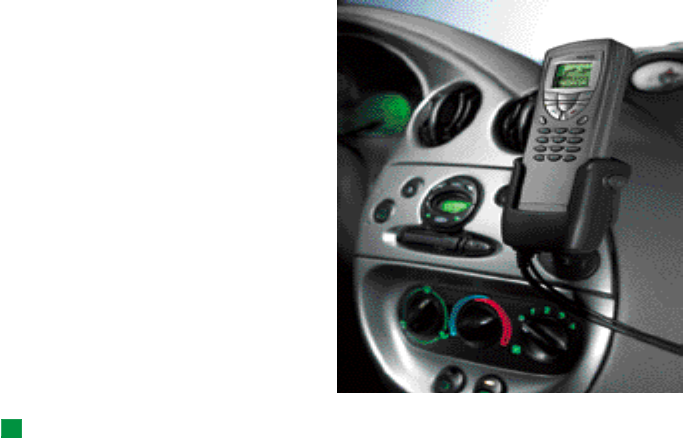
288
Accessories guide
Vehicle accessories
Advanced HF car kit CARK109
Figure 110
Tip: Battery charging
times are the same as those
for the Performance Travel
Charger ACP-12U.
The Advanced HF Car Kit CARK109 offers a convenient handsfree option in a car.
The car kit provides charging for your communicator. The car kit must be installed
by qualified personnel.

289
Accessories guide
Figure 111
The kit consists of the Advanced Active Car Holder CRM-1 (shown in Figure 111),
Advanced HF Unit HFU-2, Microphone HFM-8 and External HF Speaker HFS-12. In
addition you can use an optional Handset HSU-1 for privacy and the optional
Antenna Set AMD-2 for improved reception and increased operation (both items
supplied separately).
Place the communicator in the holder
1Close the cover of the communicator and turn the antenna to a closed position.
2Insert the communicator in the car kit holder connector end first.
3To avoid damaging the connectors, press the communicator down gently until
it is securely held by the locking mechanism.
Make a call with the car kit
1Key in the desired number with the keypad or use the search function to look
for a name and number.
2Press . For a private call, lift the handset if installed.
Answer a call
1Press , or, if the handset is installed, lift the handset.

290
Accessories guide
2If you set the Automatic answer feature on in the Car profile, the communicator
will automatically answer incoming calls.
Switch from handset operation to handsfree operation
Press the Options selection key once and replace the handset in 5 seconds. If you
do not press Options before replacing the handset, the call will end.
End a call
Press , or, if the handset is installed, replace the handset.
Ignition sense
The ignition sense feature allows the communicator to be automatically switched
on or off whenever the communicator is in the charging holder and the vehicle is
started or switched off. This prevents the communicator from draining the car
battery, if accidentally left on for a long period of time.
If installed, the ignition sense is always available. If you do not wish to enable the
ignition sense, ask your dealer to leave it uninstalled.
When the ignition is turned off, the message ‘Phone will power off, if not used’ is
displayed. The communicator will be switched off after 15 seconds unless you press
any key or take the communicator from the holder during this time.
Car mute
This feature mutes the car radio during a phone call, if supported by the car radio.
Ask your dealer to enable the car radio feature during installation.
Antenna motor control
If installed, this feature will activate the electrical motor of the mobile antenna.
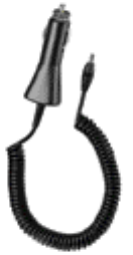
291
Accessories guide
Mobile charger LCH-9
Figure 112
The Mobile Charger LCH-9 provides an easy and convenient way to charge the
communicator battery in a vehicle. It is suitable for most vehicles’ cigarette lighter
sockets. Plug the lead from the mobile charger into the bottom connector of the
communicator.
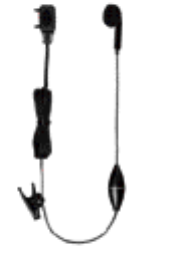
292
Accessories guide
Wearables
Headset HDC-8L
Figure 113
The Headset HDC-8 offers private headset audio operation. With the remote
control button, which is located in the microphone part of the headset, you can
answer and end a call. The headset connects directly to the connector at the
bottom of the communicator.
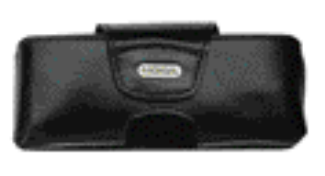
293
Accessories guide
Carrying cases
Carry case CSL-25
Figure 114
There are two different carrying cases designed especially for the Nokia 9290
Communicator. The case shown in Figure 115 (CSL-26) has a convenient shoulder
strap. Both are available from Nokia dealers.
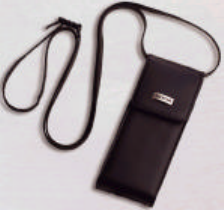
294
Accessories guide
Carrying case CSL-26
Figure 115
Mobile office
Memory card
The 16 Mbyte postage stamp sized memory card provides removable storage for
the communicator. The memory card increases the available memory for data and
software applications. For example you could load new applications to the
communicator and save files such as images, wav sounds, faxes and documents.
You could also use a memory card for different applications or address books.
For additional memory, the 64 Mbyte MMC memory card (DTS-64) can be
purchased on the www.nokiausa.com web page in accessories for the 9290
Communicator.
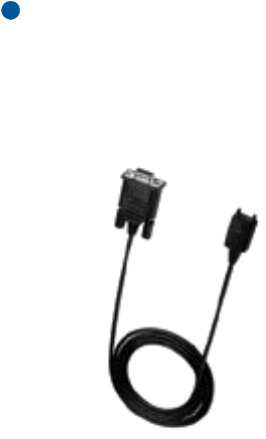
295
Accessories guide
Note: The memory cards used in Nokia 9290 Communicator are not compatible
with older models of Nokia communicator, but you can use the cards
used in Nokia 9110i Communicator in the model 9290 after formatting
them.
RS-232 Adapter cable DLR-2L
Figure 116
This versatile adapter cable provides convenient computer connectivity for data
transfer with your Nokia 9290 Communicator. It connects to the RS-232 serial port
of a compatible computer. It can also be used with the Advanced Desktop Stand
DCH-10.

296
Troubleshooting
14. Troubleshooting
You can visit Forum Nokia at www.forum.nokia.com for information and support
material related to the communicator.
WARNING! You must backup all your data on the communicator BEFORE
sending it in for repairs. All hardware is sent back to you clean.
Nokia is not responsible for any data that is on the machine when
it is sent in. Please call Customer Care before sending in your
communicator.
1. Phone or communicator interface does not start; both displays remain blank
Make sure that the battery is properly installed and charged.
Make sure that the contacts on the battery and the desktop stand are clean.
The battery charge may be too low for operation. Check the display and listen for
the low battery warning tones. Charge the battery as described on page 67. If the
NOT CHARGING message is displayed, the charging is suspended. Temperature
extremes will affect the ability of your battery to charge: allow it to cool down or
warm up first. Wait for a while, disconnect the charger, connect it again and retry.
If charging still fails, contact your local Nokia dealer.
2. Communicator interface does not start; cover phone display is flashing
The communicator memory is corrupted. Contact your local Nokia dealer.
3. The battery is attached, but the phone does not work

297
Troubleshooting
Try to switch on the phone by pressing the key for several seconds.
Check that the flight mode is not active. For more information see ‘Flight profile’
on page 133.
Restart the communicator by removing the battery, waiting thirty seconds, and
replacing it again.
Try charging the communicator. If you see the battery level indicator on the phone
but the phone does not work, contact your local Nokia dealer.
Check the signal strength indicator: you might be outside the system service area.
Make sure that the telephone service is activated for your SIM card.
Check if there is an error message on the display after switching on. If so, contact
your local dealer.
Check that the SIM card is correctly installed, see the Getting Started Guide.
4. Communicator interface is not activated or applications stop responding
Close the cover and open it again. If this does not help, close the cover and remove
the battery. Replace the battery and open the cover again. Wait while the
communicator performs a self-test and starts.
Try charging the communicator.
If the device does not respond even after several restarts (disconnect the charger,
take battery out, wait for 30 seconds, and replace the battery), remove all
temporary files as follows:
1Disconnect the charger and remove the battery to restart the communicator.
2Insert the battery and open the cover.

298
Troubleshooting
3When you see the Nokia 9290 Communicator Welcome screen, immediately
press and hold down the Ctrl+Shift+I keys. The I key should be pressed last.
4Temporary files are deleted. This empties the cache, removes cookies, resets
plugin registrations and resets the settings you have made in some of the
applications including all Internet and profile settings, Desk shortcuts and
display settings. All other applications and files stay intact.
If the procedures described above do not help, as a last resort before contacting
your local dealer you can try formatting the internal memory of the communicator.
Note that formatting the memory removes all items except the standard
applications that have been factory pre-installed in ROM memory! If you have
made a full backup with PC Suite, you can use PC Suite to format the memory and
restore the backed-up files. If you have made a backup to a memory card, see ‘Back
up and restore data to and from the memory card’ on page 259. If you have not
made a backup, but you still must format the internal memory, proceed as follows:
Tip: If you have to give
away your Communicator, it
is a good idea to format the
device and restore the
factory-installed software
from the CD-ROM. This way
the next user will be able to
start with a fresh device.
1Disconnect the charger and remove the battery to restart the communicator.
2Insert the battery and open the cover.
3When you see the Nokia 9290 Communicator Welcome screen, immediately
press and hold down the Ctrl+Shift+F keys. The F key should be pressed last.
4Formatting starts. It takes at least two minutes to complete.
5With Windows Explorer, locate the All_Nokia_9290_data.sis installation package
in the Preinstalled in device folder of the sales package CD-ROM and install it.
5. Cannot make or receive calls
Check to see if you have ‘Flight’ profile turned on. When this profile is active you
cannot make or receive calls.
Make sure that the phone is not off. Close the cover and switch on the phone.

299
Troubleshooting
If you get the message INVALID SIM CARD, your SIM card cannot be used in the
communicator. Contact you dealer or system service provider.
Check the status of your call restrictions and forwards, see ‘System services
settings’ on page 124.
The phone may be busy: data or fax is being sent or received, or the communicator
is being used as a fax modem. Wait for the data/fax transmission to end, or drop
the call by pressing the key on the phone keypad.
6. Call quality is poor
Your location may not allow better call quality. This problem may occur especially
in a moving car or train. Move to a location where the radio signal reception is
better. See ‘GSM data transmission’ on page 53.
Reception is usually better above ground level, outdoors and while stationary.
Sometimes even moving the communicator slightly will improve reception. You
can also try using the communicator in the handsfree mode, see page 112.
Remember to turn the antenna to an upright position.
7. Cannot forward or bar voice, fax or data calls
You may have not subscribed to the service in question, or it is not supported by
the system, or the message center number and the number to which you want to
forward your calls may be missing or incorrect.
Fax forwards and restrictions are defined in Tools > Account settings… in the
Messaging application. Data restriction is set in the in the Data call restrictions in
Control panel. Data calls cannot be forwarded.
8. Cannot select a contact

300
Troubleshooting
If you cannot select a contact in the Telephone, Fax, SMS or Mail directory, the
contact card does not have a telephone number, fax number, wireless phone
number or an e-mail address. Add the missing information to the contact card in
the Contacts application.
9. Cannot send or receive faxes, short messages or mail
Make sure that you have subscribed to these system services.
The phone may be off, or the communicator is low on memory.
The number format you use may be invalid, or the called number has not answered
within 10 tries, or you are calling to a wrong phone number.
The phone may be busy: data or fax is being sent or received, the communicator is
being used as a fax modem. Wait for the data/fax transmission to end, or drop the
call by pressing the key on the phone keypad.
Fax/data restrictions or fax forwards may be active. You can define the Fax
restrictions/forwards in Tools > Account settings… in Messaging.
Fax reception: Your SIM card may not have a fax number.
Mail reception: You have not subscribed to a remote mailbox service, or the mail
service you are using uses another mail protocol than what you have selected.
(Check with our Internet Service Provider whether you should be using POP3 or
IMAP4.) If you are using secure connections, your remote mailbox service also has
to support secure connections. There may also be a transient problem with the
remote mailbox service, or the Internet servers between the communicator and the
remote mailbox. Try again after a couple of minutes, and then contact your
Internet Service Provider.
301
Troubleshooting
Mail sending: You have not subscribed to a remote mailbox service, or the mail
server delivering your mail does not comply with the SMTP protocol. If you are
using secure connections, your remote mailbox service also has to support secure
connections. There may also be a transient problem with the remote mailbox
service, or the Internet servers between the communicator and the remote
mailbox. Try again after a couple of minutes, and then contact your Internet
Service Provider. If you are using the Upon request sending option, mail must be
sent in the Document outbox, see ‘Outbox’ on page 203.
If you receive service provider error messages when connecting to your remote
mailbox, contact your remote mailbox service provider. Your remote mailbox may
contain corrupted mail messages or the mail server settings may be incorrect.
If you have problems sending mail with attachments, select Cancel sending and
try again. If this does not help, try the key combination Shift-Tab-right arrow.
Some mail attachments can take up a significant amount of memory and therefore
freeing some memory by deleting something from your communicator memory
might also help.
Short message sending: You have not subscribed to the Short Message Service or
the message center number is missing or incorrect. Contact your service provider.
The reason for failure may also depend on the system: the system does not support
SMS, fax, or data/mail; the system is out of order or busy; the signal strength is not
adequate for sending.
10. Phone display shows “Message too long” when I try to open a received
short message.
The received message is over 1377 characters long. Use the Messaging application
to read it.
302
Troubleshooting
11. Cannot establish an Internet connection
If you are trying to connect to the Internet (in order to use WWW or to receive or
send mail), but the operation does not succeed, you can use the following checklist
to find out where the problem might be located:
1Is the data call active when you are trying to connect? Look at the data call
indicator on the phone side. If the data call is dropped after a few seconds after
starting to connect, check the phone number in the Internet Access settings.
See page 173 for details.
If the phone number is correct, the reason may be in poor system conditions, or
a congested GSM network. Also check the Data call settings in the Internet
Access settings (connection type, data call type, and maximum connection
speed). See page 173 for details.
Contact your system service provider if you have problems with data call
establishment, and your Internet Service Provider to find out the correct remote
modem type. If you are roaming outside your home system, you might want to
try the basic GSM data call settings described in a tip on page 178.
2If the data call is active, but you cannot receive or send mail, try to use the
WWW browser to connect to your Internet Service Provider's WWW pages. If
that works, the problem is most likely in the mail settings or the remote mailbox
service. For more information, see Mail settings on page 214.
3If the data call is active, but you cannot download WWW pages with the WWW
browser, make note of the most recent status indication displayed to you in the
title bar of the WWW browser.
•If the status indication reads Waiting for reply from host or Looking up host
address, it is likely that the WWW address (URL) has been mistyped, or there
is a problem with proxy server settings in the Internet Access Point or the
proxy server itself, or there is a transient problem with the WWW server or
303
Troubleshooting
Internet connections between the WWW server and your Internet Service
Provider. Check the proxy server settings explained on page 177. Disconnect
the call, wait for a couple of minutes, and retry the connection. If the
connection still does not succeed, contact your Internet Service Provider.
•If the status indication reads Logging into system or Connected, the problem is
most likely in your Internet Access Point settings (See page 173 for details)
or your Internet Service Provider's dial-up system, or you might need a script
in order to connect to your Internet Service Provider. Disconnect the data
call, wait for a couple of minutes, and retry the connection. If the connection
still does not succeed, contact your Internet Service Provider.
4If your data call is unexpectedly dropped, this may be a case of poor system
conditions, congestion in the phone system, or a too low inactivity period
setting.
If you are unable to connect to the Internet after repeated attempts, and have
successfully used your Internet connection previously, or get error messages when
starting the WWW browser, remove and replace the battery and try again.
12. Infrared problems
The communicator may be connected to a PC, laptop, printer, digital camera,
wireless phone or another communicator via the infrared connection.
If you are using the PC Suite for Nokia 9290 Communicator program on your PC,
or if you want to receive data from another communicator or a digital camera, you
must activate the Infrared connection on your communicator before the
connection is made. See PC Suite Guide in the sales package CD-ROM and ‘Activate
the infrared connection’ on page 82 of this guide.
304
Troubleshooting
The PC to which you want to establish the connection must have an IrDA
compatible infrared port; installed and activated IrDA drivers; and Microsoft
Windows 95/98/98SE/Me. For more information on IrDA drivers and their use in
Windows, contact Microsoft.
If you have an IBM Thinkpad laptop with Windows 98 SE installed, you may
encounter problems with infrared connections. If problems occur, proceed as
follows:
1Click the Windows Start button and select Settings > Control Panel.
2In the Windows 98 Control Panel, open System.
3In the System properties dialog, select the Device Manager tab.
4Under System Adapters, select IBM Thinkpad Fast Infrared Port and click the
Properties button. IBM Thinkpad Fast Infrared Port Properties dialog opens.
5Click the Driver tab and then click the Update Driver... button. Update Device
Driver Wizard starts.
6Click Next.
7Select the Install one of the other drivers option and click the View List... button.
8Infrared PnP Serial Port has been found. Click OK.
9Click Next.
10 Infrared PnP Serial Port is ready to be installed. Click Next.
11 The new driver has been installed. Click Finish.
12 The computer must be restarted before the new driver can be taken to use. Click
Yes to restart the computer.
13. Printing problems
If you are using the infrared connection, the infrared port of the printer must be
compatible to the IrDA standard. See ‘Print’ on page 78.
305
Troubleshooting
If you fail to establish an infrared connection, transfer the file to a PC and use the
PC to print the document. Alternatively, you can fax the document to the nearest
fax machine. See ‘Write and send a new fax’ on page 207.
14. PC connectivity problems
Make sure that PC Suite for Nokia 9290 Communicator is installed and running on
your PC. See the PC Suite Guide for more information.
If you use a cable connection, check that the cable is properly attached at both
ends.
If you use an infrared connection, check that the IR ports are facing each other and
the route between the ports is unobstructed.
Check that you are using the correct serial port (COM) on your PC.
For all other PC Suite problems, see the PC Suite Guide and the PC Suite online help
‘Troubleshooting’ section.
15. Fax modem problems
When you use the communicator as a fax modem, make sure that the
communicator and the PC use the same baud rate. If you use the infrared
connection, the baud rate is set automatically. If you use the cable connection, set
the baud rate in the Fax modem settings. For the PC, the baud rate is set in the
connectivity software of the PC.
If you use the cable connection, fully compatible operation with all PC fax and
terminal software cannot be guaranteed. Consult your dealer. If you have problems
with your PC fax software, use the infrared connection.
306
Troubleshooting
If you have problems establishing a data connection with the remote modem, try
fixing the data transmission rate by using an AT command. Common AT commands
based on the GSM 07.07 standard and supported by the Nokia 9290 Communicator
are listed in the atcomm.txt file on the CD-ROM supplied with the communicator.
You can find this file by clicking ‘AT commands” in ‘PC software section’ on the CD-
ROM. For information on how to use the AT commands and fax modem drivers,
consult the documentation of the telecommunication or fax application that you
use on your PC.
16. Access code problems
The default lock code for Nokia 9290 Communicator is 12345. If you forget or lose
the lock code contact your communicator dealer.
If you forget or lose a PIN or PUK code, or if you have not received such a code,
contact your system service provider.
For information about Internet passwords, contact your Internet service provider.
17. Low on memory
Your communicator can run out of memory just like a PC. There may be several
reasons for that:
•You have too many applications running. Press the Menu key and check the
leftmost menu for tasklist of open applications. Choose the application that
does not have to be open and close it.
•You have received a lot of mail or you have saved large images or other items
that use a lot of memory. To free up communicator memory, remove
unnecessary data, move large items to a memory card or transfer them to your
PC, if possible. See ‘’ on page 206 and PC Suite Guide for details.

307
Troubleshooting
•You have tried to download a large WWW page. See see item 19 on this
troubleshooting list.
You can check the memory usage in the Memory application of Control panel.
See ‘Memory’ on page 269.
18. Cannot connect to the Internet when roaming
You are able to connect to the Internet when in your home country or region. You
are now roaming and your Internet connection does not work. Try using the
settings of a basic GSM data connection. Also check that the phone number of
your Internet Access Point is in international format. See ‘Data call page’ on page
178.
19. ‘Memory’ error note seen when downloading very large WWW pages
Some WWW pages are extremely large because they contain many large images or
tables. These types of pages consume memory in the communicator very quickly.
If, when downloading WWW pages, you see an error note about memory, the first
action is to close any other applications that you may have opened after starting
the WWW browser. To do that, press the Menu key and check the leftmost menu
for tasklist of open applications. Select and close each item.
If you still experience problems, turn off the setting which allows loading images
automatically. One last action is to exit the WWW browser application, start it
again, and try to download the page once more without images.
Note: Removing data files or installing applications does not have effect on the
memory available to the WWW browser.
20. Some of the applications have disappeared or have been accidentally
removed.
308
Troubleshooting
You may have removed or replaced the memory card that was originally inserted
in your communicator.
If you have removed the card, re-insert it.
If you have replaced it, use PC Suite for Nokia 9290 Communicator to install
memory card applications from the Preinstalled in Memory Card folder of the sales
package CD-ROM to the new memory card.
You can also find the installation packages for the other preinstalled applications
in the Preinstalled in device folder of the sales package CD-ROM.
Re-install all the applications that are missing.
Draft
309
Reference information
15. Reference information
Important safety information
Traffic safety
Do not use a communicator while driving a vehicle. If using a communicator, park
the vehicle first. Always secure the communicator in its holder; do not place the
communicator on the passenger seat or where it can break loose in a collision or
sudden stop.
The use of an alert device to operate a vehicle's lights or horn on public roads is
not permitted.
Remember road safety always comes first!
Operating environment
Remember to follow any special regulations in force in any area and always switch
off the phone of your communicator whenever it is forbidden to use it, or when it
may cause interference or danger.
When connecting the communicator or any accessory to another device, read its
user guide for detailed safety instructions. Do not connect incompatible products.
310
Reference information
As with other mobile radio transmitting equipment, users are advised that for the
satisfactory operation of the equipment and for the safety of personnel, it is
recommended that the equipment should only be used in the normal operating
position (held to your ear with the antenna pointing over your shoulder).
Do not point the infrared beam at anyone’s eye or allow it to interfere with other
infrared devices.
To maintain compliance with radio frequency exposure guidelines, always use
Nokia approved accessories. Place the communicator in an approved carrying case
or belt clip when carrying the communicator while the phone is on.
Electronic Devices
Most modern electronic equipment is shielded from radio frequency (RF) signals.
However, certain electronic equipment may not be shielded against the RF signals
from your communicator.
Pacemakers: Pacemaker manufacturers recommend that a minimum separation
of 20 cm (6 inches) be maintained between a hand-held wireless phone and a
pacemaker to avoid potential interference with the pacemaker. These
recommendations are consistent with the independent research by and
recommendations of Wireless Technology Research. Persons with pacemakers:
Should always keep the communicator more than 20 cm (6 inches) from their
pacemaker when the phone is switched on;
Should not carry the communicator in a breast pocket;
Should use the ear opposite the pacemaker to minimize the potential for
interference.
Draft
311
Reference information
If you have any reason to suspect that interference is taking place, switch off the
phone of your communicator immediately.
Hearing aids: Some digital wireless phones may interfere with some hearing
aids. In the event of such interference, you may want to consult your service
provider.
Other medical devices: Operation of any radio transmitting equipment,
including communicators, may interfere with the functionality of inadequately
protected medical devices. Consult a physician or the manufacturer of the medical
device to determine if they are adequately shielded from external RF energy or if
you have any questions. Switch off the phone of your communicator in health care
facilities when any regulations posted in these areas instruct you to do so.
Hospitals or health care facilities may be using equipment that could be sensitive
to external RF energy.
Vehicles: RF signals may affect improperly installed or inadequately shielded
electronic systems in motor vehicles (for example electronic fuel injection systems,
electronic anti-skid (anti-lock) braking systems, electronic speed control systems,
air bag systems). Check with the manufacturer or its representative regarding your
vehicle. You should also consult the manufacturer of any equipment that has been
added to your vehicle.
Posted notices: Switch off the phone of your communicator in any facility
where posted notices so require.
312
Reference information
Potentially Explosive Atmospheres
Switch off the phone of your communicator when in any area with a potentially
explosive atmosphere and obey all signs and instructions. Sparks in such areas
could cause an explosion or fire resulting in bodily injury or even death.
Users are advised to switch off the phone when at a refueling point (service
station). Users are reminded of the need to observe restrictions on the use of radio
equipment in fuel depots (fuel storage and distribution areas), chemical plants or
where blasting operations are in progress.
Areas with a potentially explosive atmosphere are often but not always clearly
marked. They include below deck on boats; chemical transfer or storage facilities;
vehicles using liquified petroleum gas (such as propane or butane); areas where the
air contains chemicals or particles, such as grain, dust or metal powders; and any
other area where you would normally be advised to turn off your vehicle engine.
Vehicles
Only qualified personnel should service the communicator, or install the
communicator in a vehicle. Faulty installation or service may be dangerous and
may invalidate any warranty which may apply to the unit.
Check regularly that all wireless phone equipment in your vehicle is mounted and
operating properly.
Do not store or carry flammable liquids, gases or explosive materials in the same
compartment as the communicator, its parts or accessories.
Draft
313
Reference information
For vehicles equipped with an air bag, remember that an air bag inflates with great
force. Do not place objects, including both installed or portable wireless equipment
in the area over the air bag or in the air bag deployment area. If in-vehicle wireless
equipment is improperly installed and the air bag inflates, serious injury could
result.
Switch off the phone of your communicator before boarding an aircraft. The use
of wireless telephones in an aircraft may be dangerous to the operation of the
aircraft, disrupt the wireless telephone system and may be illegal.
Failure to observe these instructions may lead to suspension or denial of telephone
services to the offender, or legal action or both.
Emergency Calls
IMPORTANT!
The Nokia 9290 Communicator, like any wireless phone, operates using radio
signals, wireless and landline systems as well as user-programed functions which
cannot guarantee connection in all conditions. Therefore you should never rely
solely upon any wireless phone for essential communications (for example,
medical emergencies).
Remember, to make or receive any calls the phone must be switched on and in a
service area with adequate signal strength. Emergency calls may not be possible
on all wireless phone systems or when certain system services and/or phone
features are in use. Check with local service providers.
To make an emergency call:
1If the device cover is open, close it.
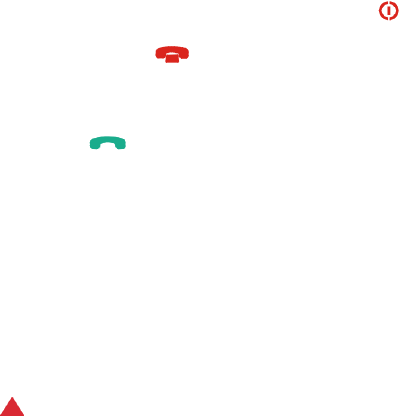
314
Reference information
2If the phone is not on, switch it on by pressing the key. Some systems may
require that a valid SIM card is properly inserted in the communicator.
3Press and hold the key for several seconds to ready the phone for calls,
and to end possible active data or fax calls.
4Key in the for your present location (for example, 911 or other official
emergency number). Emergency numbers vary by location.
5Press the key.
If certain features are in use (call restrictions, fixed dialing, system lock, keypad
lock, etc.), you may first need to turn those features off before you can make an
emergency call. Consult this document and your local cellular service provider.
When making an emergency call, remember to give all the necessary information
as accurately as possible. Remember that your communicator may be the only
means of communication at the scene of an accident - do not cut off the call until
given permission to do so.
Important power supply information
WARNING: This apparatus is intended for use when supplied with power
from a Lithium-ion battery and chargers ACP-12U and
LCH-9. Other usage will invalidate any approval given to this
apparatus and may be dangerous. Use only batteries, chargers
and accessories approved by the communicator manufacturer
for use with this particular communicator model. The use of
any other types will invalidate any approval or warranty
applying to the communicator, and may be dangerous. For
Draft
315
Reference information
availability of approved accessories, please check with your
dealer.When you disconnect the power cord of any accessory,
grasp and pull the plug, not the cord.
Certification Information (SAR)
THIS MODEL PHONE MEETS THE GOVERNMENT'S REQUIREMENTS FOR EXPOSURE
TO RADIO WAVES.
Your wireless phone is a radio transmitter and receiver. It is designed and
manufactured not to exceed the emission limits for exposure to radio frequency
(RF) energy set by the Federal Communications Commission of the U.S.
Government. These limits are part of comprehensive guidelines and establish
permitted levels of RF energy for the general population. The guidelines are based
on standards that were developed by independent scientific organizations through
periodic and thorough evaluation of scientific studies. The standards include a
substantial safety margin designed to assure the safety of all persons, regardless
of age and health.
The exposure standard for wireless mobile phones employs a unit of measurement
known as the Specific Absorption Rate, or SAR. The SAR limit set by the FCC is
1.6W/kg.* Tests for SAR are conducted using standard operating positions accepted
by the FCC with the phone transmitting at its highest certified power level in all
tested frequency bands. Although the SAR is determined at the highest certified
power level, the actual SAR level of the phone while operating can be well below
the maximum value. This is because the phone is designed to operate at multiple
power levels so as to use only the power required to reach the network. In general,
the closer you are to a wireless base station antenna, the lower the power output.
316
Reference information
Before a phone model is available for sale to the public, it must be tested and
certified to the FCC that it does not exceed the limit established by the
government-adopted requirement for safe exposure. The tests are performed in
positions and locations (for example, at the ear and worn on the body) as required
by the FCC for each model. The highest SAR value for this model phone as reported
to the FCC when tested for use at the ear is 0.43W/kg and when worn on the body,
as described in this user guide, is 0.33W/kg. (Body-worn measurements differ
among phone models, depending upon available accessories and FCC
requirements).
While there may be differences between the SAR levels of various phones and at
various positions, they all meet the government requirement.
The FCC has granted an Equipment Authorization for this model phone with all
reported SAR levels evaluated as in compliance with the FCC RF exposure
guidelines. SAR information on this model phone is on file with the FCC and can
be found under the Display Grant section of
http://www.fcc.gov/oet/fccid after searching on FCC ID: PDN RAB-3N.
For body worn operation, this phone has been tested and meets the FCC RF
exposure guidelines when used with the Nokia accessories supplied or designated
for this product. Use of other accessories may not ensure complicance with FCC RF
exposure guidelines.
*In the United States and Canada, the SAR limit for mobile phones used by the
public is 1.6 watts/kilogram (W/kg) averaged over one gram of tissue. The standard
incorporates a substantial margin of safety to give additional protection for the
public and to account for any variations in measurements. SAR values may vary
Draft
317
Reference information
depending on national reporting requirements and the network band. For SAR
information in other regions please look under product information at
www.nokia.com.
Safety is the most important call you will ever make.
A Guide to Safe and Responsible Wireless Phone Use
Tens of millions of people in the u.s. today take advantage of the unique combination of
convenience, safety and value delivered by the wireless telephone. Quite simply, the wireless
phone gives people the powerful ability to communicate by voice--almost anywhere,
anytime--with the boss, with a client, with the kids, with emergency personnel or even with
the police. each year, americans make billions of calls from their wireless phones, and the
numbers are rapidly growing.
But an important responsibility accompanies those benefits, one that every wireless phone
user must uphold. When driving a car, driving is your first responsibility. A wireless phone can
be an invaluable tool, but good judgment must be exercised at all times while driving a motor
vehicle--whether on the phone or not.
The basic lessons are ones we all learned as teenagers. Driving requires alertness, caution and
courtesy. It requires a heavy dose of basic common sense---keep your head up, keep your
eyes on the road, check your mirrors frequently and watch out for other drivers. It requires
obeying all traffic signs and signals and staying within the speed limit. It means using
seatbelts and requiring other passengers to do the same.
But with wireless phone use, driving safely means a little more. This brochure is a call to
wireless phone users everywhere to make safety their first priority when behind the wheel of
a car. Wireless telecommunications is keeping us in touch, simplifying our lives, protecting
us in emergencies and providing opportunities to help others in need.
When it comes to the use of wireless phones, safety is your most important call.
Wireless Phone "Safety Tips"
Below are safety tips to follow while driving and using a wireless phone which should be easy
to remember.
1Get to know your wireless phone and its features such as speed dial and redial. Carefully
read your instruction manual and learn to take advantage of valuable features most
phones offer, including automatic redial and memory. Also, work to memorize the phone
keypad so you can use the speed dial function without taking your attention off the road.
318
Reference information
2When available, use a hands free device. A number of hands free wireless phone
accessories are readily available today. Whether you choose an installed mounted device
for your wireless phone or a speaker phone accessory, take advantage of these devices if
available to you.
3Position your wireless phone within easy reach. Make sure you place your wireless phone
within easy reach and where you can grab it without removing your eyes from the road.
If you get an incoming call at an inconvenient time, if possible, let your voice mail answer
it for you.
4Suspend conversations during hazardous driving conditions or situations. Let the person
you are speaking with know you are driving; if necessary, suspend the call in heavy traffic
or hazardous weather conditions. Rain, sleet, snow and ice can be hazardous, but so is
heavy traffic. As a driver, your first responsibility is to pay attention to the road.
5Do not take notes or look up phone numbers while driving. If you are reading an address
book or business card, or writing a "to do" list while driving a car, you are not watching
where you are going. It’s common sense. Don’t get caught in a dangerous situation
because you are reading or writing and not paying attention to the road or nearby
vehicles.
6Dial sensibly and assess the traffic; if possible, place calls when you are not moving or
before pulling into traffic. Try to plan your calls before you begin your trip or attempt to
coincide your calls with times you may be stopped at a stop sign, red light or otherwise
stationary. But if you need to dial while driving, follow this simple tip--dial only a few
numbers, check the road and your mirrors, then continue.
7Do not engage in stressful or emotional conversations that may be distracting. Stressful
or emotional conversations and driving do not mix--they are distracting and even
dangerous when you are behind the wheel of a car. Make people you are talking with
aware you are driving and if necessary, suspend conversations which have the potential
to divert your attention from the road.
8Use your wireless phone to call for help. Your wireless phone is one of the greatest tools
you can own to protect yourself and your family in dangerous situations--with your
phone at your side, help is only three numbers away. Dial 9-1-1 or other local emergency
number in the case of fire, traffic accident, road hazard or medical emergency. Remember,
it is a free call on your wireless phone!
9Use your wireless phone to help others in emergencies. Your wireless phone provides you
a perfect opportunity to be a "Good Samaritan" in your community. If you see an auto
accident, crime in progress or other serious emergency where lives are in danger, call 9-
1-1 or other local emergency number, as you would want others to do for you.
Draft
319
Reference information
10 Call roadside assistance or a special wireless non-emergency assistance number when
necessary. Certain situations you encounter while driving may require attention, but are
not urgent enough to merit a call for emergency services. But you still can use your
wireless phone to lend a hand. If you see a broken-down vehicle posing no serious hazard,
a broken traffic signal, a minor traffic accident where no one appears injured or a vehicle
you know to be stolen, call roadside assistance or other special non-emergency wireless
number.
Careless, distracted individuals and people driving irresponsibly represent a hazard to
everyone on the road. Since 1984, the Cellular Telecommunications Industry Association and
the wireless industry have conducted educational outreach to inform wireless phone users of
their responsibilities as safe drivers and good citizens. As we approach a new century, more
and more of us will take advantage of the benefits of wireless telephones. And, as we take
to the roads, we all have a responsibility to drive safely.
The wireless industry reminds you to use your phone safely when driving.
For more information, please call 1-888-901-SAFE.
For updates: http://www.wow-com.com/consumer/issues/driving/articles.cfm?ID=85
© 2001 Cellular Telecommunications & Internet Association. All Rights Reserved.1250
Connecticut Avenue, NW Suite 800, Washington, DC 20036. Phone: (202) 785-0081
Consumer Update on Wireless Phones
U.S. Food and Drug Administration
1. Do wireless phones pose a health hazard?
The available scientific evidence does not show that any health problems are associated with
using wireless phones. There is no proof, however, that wireless phones are absolutely safe.
Wireless phones emit low levels of radiofrequency energy (RF) in the microwave range while
being used. They also emit very low levels of RF when in the stand-by mode. Whereas high
levels of RF can produce health effects (by heating tissue), exposure to low level RF that does
not produce heating effects causes no known adverse health effects. Many studies of low
level RF exposures have not found any biological effects. Some studies have suggested that
some biological effects may occur, but such findings have not been confirmed by additional
research. In some cases, other researchers have had difficulty in reproducing those studies,
or in determining the reasons for inconsistent results.
2. What is FDA's role concerning the safety of wireless phones?
320
Reference information
Under the law, FDA does not review the safety of radiation-emitting consumer products such
as wireless phones before they can be sold, as it does with new drugs or medical devices.
However, the agency has authority to take action if wireless phones are shown to emit
radiofrequency energy (RF) at a level that is hazardous to the user. In such a case, FDA could
require the manufacturers of wireless phones to notify users of the health hazard and to
repair, replace or recall the phones so that the hazard no longer exists.
Although the existing scientific data do not justify FDA regulatory actions, FDA has urged the
wireless phone industry to take a number of steps, including the following:
•Support needed research into possible biological effects of RF of the type emitted by
wireless phones;
•Design wireless phones in a way that minimizes any RF exposure to the user that is not
necessary for device function; and
•Cooperate in providing users of wireless phones with the best possible information on
possible effects of wireless phone use on human health.
FDA belongs to an interagency working group of the federal agencies that have responsibility
for different aspects of RF safety to ensure coordinated efforts at the federal level. The
following agencies belong to this working group:
•National Institute for Occupational Safety and Health
•Environmental Protection Agency
•Federal Communications Commission
•Occupational Safety and Health Administration
•National Telecommunications and Information Administration
The National Institutes of Health participates in some interagency working group activities,
as well.
FDA shares regulatory responsibilities for wireless phones with the Federal Communications
Commission (FCC). All phones that are sold in the United States must comply with FCC safety
guidelines that limit RF exposure. FCC relies on FDA and other health agencies for safety
questions about wireless phones.
FCC also regulates the base stations that the wireless phone networks rely upon. While these
base stations operate at higher power than do the wireless phones themselves, the RF
exposures that people get from these base stations are typically thousands of times lower
than those they can get from wireless phones. Base stations are thus not the subject of the
safety questions discussed in this document.
Draft
321
Reference information
3. What kinds of phones are the subject of this update?
The term wireless phone refers here to hand-held wireless phones with built-in antennas,
often called cell mobile or PCS phones. These types of wireless phones can expose the user
to measurable radiofrequency energy (RF) because of the short distance between the phone
and the user’s head. These RF exposures are limited by Federal Communications Commission
safety guidelines that were developed with the advice of FDA and other federal health and
safety agencies. When the phone is located at greater distances from the user, the exposure
to RF is drastically lower because a person's RF exposure decreases rapidly with increasing
distance from the source. The so-called cordless phones; which have a base unit connected
to the telephone wiring in a house, typically operate at far lower power levels, and thus
produce RF exposures far below the FCC safety limits.
4. What are the results of the research done already?
The research done thus far has produced conflicting results, and many studies have suffered
from flaws in their research methods. Animal experiments investigating the effects of
radiofrequency energy (RF) exposures characteristic of wireless phones have yielded
conflicting results that often cannot be repeated in other laboratories. A few animal studies,
however, have suggested that low levels of RF could accelerate the development of cancer in
laboratory animals. However, many of the studies that showed increased tumor development
used animals that had been genetically engineered or treated with cancer-causing chemicals
so as to be pre-disposed to develop cancer in the absence of RF exposure. Other studies
exposed the animals to RF for up to 22 hours per day. These conditions are not similar to the
conditions under which people use wireless phones, so we don’t know with certainty what
the results of such studies mean for human health.
Three large epidemiology studies have been published since December 2000. Between them,
the studies investigated any possible association between the use of wireless phones and
primary brain cancer, glioma, meningioma, or acoustic neuroma, tumors of the brain or
salivary gland, leukemia, or other cancers. None of the studies demonstrated the existence
of any harmful health effects from wireless phone RF exposures. However, none of the studies
can answer questions about long-term exposures, since the average period of phone use in
these studies was around three years.
322
Reference information
5. What research is needed to decide whether RF exposure from wireless phones
poses a health risk?
A combination of laboratory studies and epidemiological studies of people actually using
wireless phones would provide some of the data that are needed. Lifetime animal exposure
studies could be completed in a few years. However, very large numbers of animals would be
needed to provide reliable proof of a cancer promoting effect if one exists. Epidemiological
studies can provide data that is directly applicable to human populations, but 10 or more
years follow-up may be needed to provide answers about some health effects, such as cancer.
This is because the interval between the time of exposure to a cancer-causing agent and the
time tumors develop - if they do - may be many, many years. The interpretation of
epidemiological studies is hampered by difficulties in measuring actual RF exposure during
day-to-day use of wireless phones. Many factors affect this measurement, such as the angle
at which the phone is held, or which model of phone is used.
6. What is FDA doing to find out more about the possible health effects of
wireless phone RF?
FDA is working with the U.S. National Toxicology Program and with groups of investigators
around the world to ensure that high priority animal studies are conducted to address
important questions about the effects of exposure to radiofrequency energy (RF).
FDA has been a leading participant in the World Health Organization International
Electromagnetic Fields (EMF) Project since its inception in 1996. An influential result of this
work has been the development of a detailed agenda of research needs that has driven the
establishment of new research programs around the world. The Project has also helped
develop a series of public information documents on EMF issues.
FDA and the Cellular Telecommunications & Internet Association (CTIA) have a formal
Cooperative Research and Development Agreement (CRADA) to do research on wireless
phone safety. FDA provides the scientific oversight, obtaining input from experts in
government, industry, and academic organizations. CTIA-funded research is conducted
through contracts to independent investigators. The initial research will include both
laboratory studies and studies of wireless phone users. The CRADA will also include a broad
assessment of additional research needs in the context of the latest research developments
around the world.
7. How can I find out how much radiofrequency energy exposure I can get by
using my wireless phone?
Draft
323
Reference information
All phones sold in the United States must comply with Federal Communications Commission
(FCC) guidelines that limit radiofrequency energy (RF) exposures. FCC established these
guidelines in consultation with FDA and the other federal health and safety agencies. The FCC
limit for RF exposure from wireless telephones is set at a Specific Absorption Rate (SAR) of
1.6 watts per kilogram (1.6 W/kg). The FCC limit is consistent with the safety standards
developed by the Institute of Electrical and Electronic Engineering (IEEE) and the National
Council on Radiation Protection and Measurement. The exposure limit takes into
consideration the body’s ability to remove heat from the tissues that absorb energy from the
wireless phone and is set well below levels known to have effects.
Manufacturers of wireless phones must report the RF exposure level for each model of phone
to the FCC. The FCC website (http://www.fcc.gov/oet/rfsafety) gives directions for locating
the FCC identification number on your phone so you can find your phone’s RF exposure level
in the online listing.
8. What has FDA done to measure the radiofrequency energy coming from
wireless phones?
The Institute of Electrical and Electronic Engineers (IEEE) is developing a technical standard
for measuring the radiofrequency energy (RF) exposure from wireless phones and other
wireless handsets with the participation and leadership of FDA scientists and engineers. The
standard, Recommended Practice for Determining the Spatial-Peak Specific Absorption Rate
(SAR) in the Human Body Due to Wireless Communications Devices: Experimental
Techniques, sets forth the first consistent test methodology for measuring the rate at which
RF is deposited in the heads of wireless phone users. The test method uses a tissue-simulating
model of the human head. Standardized SAR test methodology is expected to greatly improve
the consistency of measurements made at different laboratories on the same phone. SAR is
the measurement of the amount of energy absorbed in tissue, either by the whole body or a
small part of the body. It is measured in watts/kg (or milliwatts/g) of matter. This
measurement is used to determine whether a wireless phone complies with safety guidelines.
9. What steps can I take to reduce my exposure to radiofrequency energy from my
wireless phone?
If there is a risk from these products--and at this point we do not know that there is--it is
probably very small. But if you are concerned about avoiding even potential risks, you can
take a few simple steps to minimize your exposure to radiofrequency energy (RF). Since time
is a key factor in how much exposure a person receives, reducing the amount of time spent
using a wireless phone will reduce RF exposure.
324
Reference information
If you must conduct extended conversations by wireless phone every day, you could place
more distance between your body and the source of the RF, since the exposure level drops
off dramatically with distance. For example, you could use a headset and carry the wireless
phone away from your body or use a wireless phone connected to a remote antenna.
Again, the scientific data do not demonstrate that wireless phones are harmful. But if you
are concerned about the RF exposure from these products, you can use measures like those
described above to reduce your RF exposure from wireless phone use.
10. What about children using wireless phones?
The scientific evidence does not show a danger to users of wireless phones, including children
and teenagers. If you want to take steps to lower exposure to radiofrequency energy (RF), the
measures described above would apply to children and teenagers using wireless phones.
Reducing the time of wireless phone use and increasing the distance between the user and
the RF source will reduce RF exposure.Some groups sponsored by other national governments
have advised that children be discouraged from using wireless phones at all. For example, the
government in the United Kingdom distributed leaflets containing such a recommendation
in December 2000. They noted that no evidence exists that using a wireless phone causes
brain tumors or other ill effects. Their recommendation to limit wireless phone use by
children was strictly precautionary; it was not based on scientific evidence that any health
hazard exists.
11.What about wireless phone interference with medical equipment?
Radiofrequency energy (RF) from wireless phones can interact with some electronic devices.
For this reason, FDA helped develop a detailed test method to measure electromagnetic
interference (EMI) of implanted cardiac pacemakers and defibrillators from wireless
telephones. This test method is now part of a standard sponsored by the Association for the
Advancement of Medical instrumentation (AAMI). The final draft, a joint effort by FDA,
medical device manufacturers, and many other groups, was completed in late 2000. This
standard will allow manufacturers to ensure that cardiac pacemakers and defibrillators are
safe from wireless phone EMI. FDA has tested hearing aids for interference from handheld
wireless phones and helped develop a voluntary standard sponsored by the Institute of
Electrical and Electronic Engineers (IEEE). This standard specifies test methods and
performance requirements for hearing aids and wireless phones so that that no interference
occurs when a person uses a compatible phone and a accompanied hearing aid at the same
time. This standard was approved by the IEEE in 2000.
FDA continues to monitor the use of wireless phones for possible interactions with other
medical devices. Should harmful interference be found to occur, FDA will conduct testing to
assess the interference and work to resolve the problem.

Draft
325
Reference information
12.Where can I find additional information?
For additional information, please refer to the following resources:
•FDA web page on wireless phones
http://www.fda.gov/cdrh/phones/index.html
•Federal Communications Commission (FCC) RF Safety Program
http://www.fcc.gov/oet/rfsafety
•International Commission on Non-Ionizing Radiation Protection
http://www.icnirp.de
•World Health Organization (WHO) International EMF Project
http://www.who.int/emf
•National Radiological Protection Board (UK)
http://www.nrpb.org.uk/
July 18, 2001 For updates: http://www.fda.gov/cdrh/phones
Care and maintenance
Your Nokia 9290 Communicator is a product of superior design and craftsmanship
and should be treated with care. The suggestions below will help you to fulfil any
warranty obligations and to enjoy this product for many years. When using your
communicator, battery, charger OR any accessory:
Keep it and all its parts and accessories out of small children's reach.
Keep it dry. Precipitation, humidity and liquids contain minerals that will corrode
electronic circuits.
Do not use or store it in dusty, dirty areas. Its moving parts can be damaged.
Do not store it in hot areas. High temperatures can shorten the life of electronic
devices, damage batteries, and warp or melt certain plastics.
326
Reference information
Do not store it in cold areas. When the communicator warms up (to its normal
temperature), moisture can form inside the communicator, which may damage
electronic circuit boards.
Do not attempt to open it. Non-expert handling of the device may damage it.
Do not drop, knock or shake it. Rough handling can break internal circuit boards.
Dropping the product may break the color display, which is fragile.
Do not use harsh chemicals, cleaning solvents, or strong detergents to clean it.
Wipe it with a soft cloth slightly dampened in a mild soap-and-water solution.
Do not paint it. Paint can clog the device’s moving parts and prevent proper
operation.
Use only the supplied or an approved replacement antenna. Unauthorized
antennas, modifications or attachments could damage the communicator and may
violate regulations governing radio devices.
If the communicator, battery, charger or any accessory is not working properly,
take it to your nearest qualified service facility. The personnel there will assist you
and, if necessary, arrange for service.
Accessory safety
A few practical rules for accessory operation:
•Keep all accessories out of the reach of small children.
•When you disconnect the power cord of any accessory, grasp and pull the
plug, not the cord.
•Check regularly that any vehicle-installed accessories are mounted and
Draft
327
Reference information
are operating properly.
•Installation of any complex car accessories must be made by qualified
personnel only.
•Use only batteries, chargers, and accessories that have been approved by
the phone manufacturer. The use of any other types could invalidate any
approval or warranty applying to the phone and could be dangerous.
Battery safety
Charging and Discharging
Your phone is powered by a rechargeable battery.
Note that a new battery's full performance is achieved only after two or three
complete charge and discharge cycles!
The battery can be charged and discharged hundreds of times but it will eventually
wear out. When the operating time (talk-time and standby time) is noticeably
shorter than normal, it is time to buy a new battery.
Use only batteries approved by the phone manufacturer and recharge your battery
only with the chargers approved by the manufacturer. Unplug the charger when
not in use. Do not leave the battery connected to a charger for longer than a week,
since overcharging may shorten its lifetime. If left unused, a fully charged battery
will discharge itself over time.
Temperature extremes can affect the ability of your battery to charge.

328
Reference information
Leaving the battery in hot or cold places, such as in a closed car in summer or
winter conditions, will reduce the capacity and lifetime of the battery. Always try
to keep the battery between 15°C and 25°C (59°F and 77°F). A phone with a hot or
cold battery may temporarily not work, even when the battery is fully charged.
Batteries' performance is particularly limited in temperatures well below freezing.
Do not dispose of batteries in a fire!
Dispose of batteries according to local regulations (for example, recycling). Do not
dispose as household waste.
Technical data
Weight 244 g (8.6 oz.)
Size 158 x 56 x 27 mm (6.22 x 2.20 x 1.06 inches)
Frequency Range
Transmitter Output Power
Battery Voltage
Charging current 1300 mAh Lithium-ion battery
Operating Temperature
Number of Channels
Number of NAMs
Memory Locations
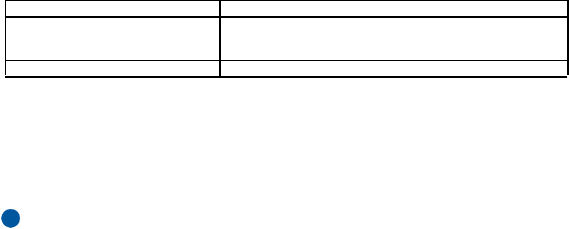
Draft
329
Reference information
NOKIA One Year Limited Warranty for US
Note: This warranty is applicable to US residents ONLY.
Nokia Inc. (“Nokia”) warrants that this cellular phone (“Product”) is free from
defects in material and workmanship that result in Product failure during normal
usage, according to the following terms and conditions:
1The limited warranty for the Product extends for ONE (1) year beginning on
the date of the purchase of the Product. This one year period is extended
by each whole day that the Product is out of your possession for repair
under this warranty.
2The limited warranty extends only to the original purchaser (“Consumer”) of
the Product and is not assignable or transferable to any subsequent
purchaser/end- user.
3The limited warranty extends only to Consumers who purchase the
Product in the United States of America.
4During the limited warranty period, Nokia will repair, or replace, at Nokia’s
sole option, any defective parts, or any parts that will not properly operate
Memory Capacity
Data/fax transmission rate
Fax type
330
Reference information
for their intended use with new or refurbished replacement items if such
repair or replacement is needed because
of product malfunction or failure during normal usage. No charge
will be made to the Consumer for any such parts. Nokia will also
pay for the labor charges incurred by Nokia in repairing or replacing the
defective parts. The limited warranty does not cover defects in
appearance, cosmetic, decorative or structural items, including framing,
and any non-operative parts. Nokia’s limit of liability under the limited
warranty shall be the actual cash value of the Product at the time the
Consumer returns the Product for repair, determined by the price paid by
the Consumer for the Product less a reasonable amount for usage. Nokia
shall not be liable for any other losses or damages. These remedies are the
Consumer’s exclusive remedies for breach of warranty.
5Upon request from Nokia, the Consumer must prove the date of the
original purchase of the Product by a dated bill of sale or dated itemized
receipt.
6The Consumer shall bear the cost of shipping the Product to Nokia in
Melbourne, Florida. Nokia shall bear the cost of shipping the Product back
to the Consumer after the completion of service under this limited
warranty.
7The Consumer shall have no coverage or benefits under this limited
warranty if any of the following conditions are applicable:
a) The Product has been subjected to abnormal use, abnormal conditions,
improper storage, exposure to moisture or dampness, unauthorized
modifications, unauthorized connections, unauthorized repair, misuse,
neglect, abuse, accident, alteration, improper installation, or other
Draft
331
Reference information
acts which are not the fault of Nokia, including damage caused by
shipping.
b) The Product has been damaged from external causes such as collision
with an object, or from fire, flooding, sand, dirt, windstorm, lightning,
earthquake or damage from exposure to weather conditions, an Act of
God, or battery leakage, theft, blown fuse, or improper use of any
electrical source, damage caused by computer or internet viruses,
bugs, worms, Trojan Horses, cancelbots or damage caused by the
connection to other products not recommended for interconnection
by Nokia.
c) Nokia was not advised in writing by the Consumer of the alleged
defect or malfunction of the Product within fourteen (14) days after
the expiration of the applicable limited warranty period.
d) The Product serial number plate or the accessory data code has been
removed, defaced or altered.
e) The defect or damage was caused by the defective function of the
cellular system or by inadequate signal reception by the external
antenna, or viruses or other software problems introduced into the
Product.
8Nokia does not warrant uninterrupted or error-free operation of the
Product. If a problem develops during the limited warranty period, the
Consumer shall take the following step-by-step procedure:
a) The Consumer shall return the Product to the place of purchase for
repair or replacement processing.
b) If “a” is not convenient because of distance (more than 50 miles) or
332
Reference information
for other good cause, the Consumer shall ship the Product prepaid and
insured to:
Nokia Inc., Attn: Repair Department
795 West Nasa Blvd.
Melbourne, FL 32901
c) The Consumer shall include a return address, daytime phone number
and/or fax number, complete description of the problem, proof of
purchase and service agreement (if applicable). Expenses related to
removing the Product from an installation are not covered under this
limited warranty.
d) The Consumer will be billed for any parts or labor charges not covered
by this limited warranty. The Consumer will be responsible for any
expenses related to reinstallation of the Product.
e) Nokia will repair the Product under the limited warranty within 30
days after receipt of the Product. If Nokia cannot perform repairs
covered under this limited warranty within 30 days, or after a
reasonable number of attempts to repair the same defect, Nokia at its
option, will provide a replacement Product or refund the purchase
price of the Product less a reasonable amount for usage. In some
states the Consumer may have the right to a loaner if the repair of the
Product takes more than ten (10) days. Please contact the Customer
Service Center at Nokia at the telephone number listed at the end of
this warranty if you need a loaner and the repair of the Product has
taken or is estimated to take more than ten (10) days.
f) If the Product is returned during the limited warranty period, but the
problem with the Product is not covered under the terms and
Draft
333
Reference information
conditions of this limited warranty, the Consumer will be notified and
given an estimate of the charges the Consumer must pay to have the
Product repaired, with all shipping charges billed to the Consumer. If
the estimate is refused, the Product will be returned freight collect. If
the Product is returned after the expiration of the limited warranty
period, Nokia’s normal service policies shall apply and the Consumer
will be responsible for all shipping charges.
9YOU (THE CONSUMER) UNDERSTAND THAT THE PRODUCT MAY CONSIST OF
REFURBISHED EQUIPMENT THAT CONTAINS USED COMPONENTS, SOME
OF WHICH HAVE BEEN REPROCESSED. The used components comply with
Product performance and reliability specifications.
10 ANY IMPLIED WARRANTY OF MERCHANTABILITY, OR FITNESS FOR A
PARTICULAR PURPOSE OR USE, SHALL BE LIMITED TO THE DURATION OF
THE FOREGOING LIMITED WRITTEN WARRANTY. OTHERWISE, THE
FOREGOING LIMITED WARRANTY IS THE CONSUMER’S SOLE AND
EXCLUSIVE REMEDY AND IS IN LIEU OF ALL OTHER WARRANTIES, EXPRESS
OR IMPLIED. NOKIA SHALL NOT BE LIABLE FOR SPECIAL, INCIDENTAL,
PUNITIVE OR CONSEQUENTIAL DAMAGES, INCLUDING BUT NOT LIMITED
TO LOSS OF ANTICIPATED BENEFITS OR PROFITS, LOSS OF SAVINGS OR
REVENUE, LOSS OF DATA, PUNITIVE DAMAGES, LOSS OF USE OF THE
PRODUCT OR ANY ASSOCIATED EQUIPMENT, COST OF CAPITAL, COST OF
ANY SUBSTITUTE EQUIPMENT OR FACILITIES, DOWNTIME, THE CLAIMS OF
ANY THIRD PARTIES, INCLUDING CUSTOMERS, AND INJURY TO PROPERTY,
RESULTING FROM THE PURCHASE OR USE OF THE PRODUCT OR ARISING
FROM BREACH OF THE WARRANTY, BREACH OF CONTRACT, NEGLIGENCE,
STRICT TORT, OR ANY OTHER LEGAL OR EQUITABLE THEORY, EVEN IF
NOKIA KNEW OF THE LIKELIHOOD OF SUCH DAMAGES. NOKIA SHALL NOT
334
Reference information
BE LIABLE FOR DELAY IN RENDERING SERVICE UNDER THE LIMITED
WARRANTY, OR LOSS OF USE DURING THE PERIOD THAT THE PRODUCT IS
BEING REPAIRED.
11 Some states do not allow limitation of how long an implied warranty lasts,
so the one year warranty limitation may not apply to you (the Consumer).
Some states do not allow the exclusion or limitation of incidental and
consequential damages, so certain of the above limitations or exclusions
may not apply to you (the Consumer). This limited warranty gives the
Consumer specific legal rights and the Consumer may also have other
rights which vary from state to state.
12 Nokia neither assumes nor authorizes any authorized service center or any
other person or entity to assume for it any other obligation or liability
beyond that which is expressly provided for in this limited warranty
including the provider or seller of any extended warranty or service
agreement.
13 This is the entire warranty between the Nokia and the Consumer, and
supersedes all prior and contemporaneous agreements or understandings, oral
or written, relating to the Product, and no representation, promise or
condition not contained herein shall modify these terms.
14 This limited warranty allocates the risk of failure of the Product between
the Consumer and Nokia. The allocation is recognized by
the Consumer and is reflected in the purchase price.
15 Any action or lawsuit for breach of warranty must be commenced within
eighteen (18) months following purchase of the Product.
16 Questions concerning this limited warranty may be directed to:
Nokia Inc.

Draft
335
Reference information
Attn: Customer Service
7725 Woodland Center Blvd., Ste. 150
Tampa, FL 33614
Telephone: 1-888-NOKIA-2U (1-888-665-4228)
Facsimile: (813) 287-6612
TTY/TDD Users Only: 1-800-24-NOKIA (1-800-246-6452)
17 The limited warranty period for Nokia supplied attachments and
accessories is specifically defined within their own warranty cards and
packaging.
*Nokia is a registered trademark of Nokia Corporation.
Nokia One Year Limited Warranty for
Canada
Note: This warranty is applicable to Canadian residents ONLY.
Nokia warrants that the Nokia wireless phone and accessories are free from
defects in material and workmanship. The warranty period for the Phone (Radio)
units and all accessories (excluding carry cases) is twelve (12) months from the
date of purchase OR fourteen (14) months from date of wholesale shipment from
Nokia, OR fifteen (15) months from the date of manufacture by Nokia. The
warranty period for the Carry cases is three (3) months from the date of Purchase
or five (5) months from the date of wholesale shipment from Nokia.
336
Reference information
During the warranty period, Nokia will, at its option, repair or replace the defective
product free of charge. Replacement Product may be either new or
remanufactured or refurbished.
However, if Nokia determines that the warranty conditions cannot be applied, the
purchaser will be billed for the repair and shipping.
EXCEPTIONS
This warranty is subject to the following exceptions:
1. Mobile or fixed installation, which is not in accordance with the installation
instructions, published by Nokia, will void the warranty. Damage caused by a repair
or an attempt to repair by other than a service centre authorized by Nokia will void
the warranty;
2. This warranty covers normal consumer use and does not cover defects or damage
to any product which, in the sole opinion of Nokia, has been subject to: improper
storage, exposure to moisture or dampness, exposure to fire, sand, dirt, windstorm,
lightning, or earthquake: to theft, battery leakage, unauthorized modification,
misuse, neglect, abuse, misapplication, accident, alteration, improper installation,
maladjustment of consumer controls, or abnormal operating conditions, or which
has been attributable to acts of God:
3. Fuses are not covered by the warranty;
4. This warranty does not cover defects or damages caused by a product which is
not approved by Nokia to be connected to its wireless phone;
5. This warranty does not cover defects or damages caused by improper or
defective function of the carrier system or by inadequate signal reception by the
antenna;

Draft
337
Reference information
6. Removal and reinstallation costs are not covered by this warranty;
7. This warranty is applicable only to products bought through Nokia Products Ltd.
in Ajax, Ontario, Canada, and sold either in Canada or Bermuda.
8. Removal, alteration, or defacing of the Serial Number Plate, or the accessory
Date Code Labels will void the warranty.
In no event shall Nokia be liable for incidental, special, or consequential damages,
direct or indirect, loss of unanticipated benefits or profits, loss of use of its wireless
telephone, resulting from the use of its wireless phone, or its accessories, or arising
from any breach of this warranty.
CLAIM PROCEDURE
In order to obtain warranty performance, return the defective unit to the Nokia
Service Centre with transportation charges prepaid (Shipping of the repaired unit
may be paid by Nokia, in which case Nokia shall have risk of loss or damage during
this shipment).
The proof of date of purchase will be required before in-warranty service is
rendered.
Maintenance and service may be obtained in any authorized service centre in
Canada.
EXTENSION OF WARRANTY PERIOD
When a repair is made, an extra 90-day service warranty is given to the labour and
parts of the repair concerned. If replacement of a faulty unit is applied, instead of
repairing, this 90-day service warranty is applied to the replaced unit.
338
Reference information
Besides this 90-day service warranty, the warranty repairs or replacements do not
affect the original warranty conditions, which are determined by the date of
purchase.
THE FOREGOING WARRANTY IS THE PURCHASER’S SOLE AND EXCLUSIVE REMEDY
AND IS IN LIEU OF ALL OTHER WARRANTIES, EXPRESSED OR IMPLIED, INCLUDING
BUT NOT LIMITED TO ANY IMPLIED WARRANTY OR MERCHANTABILITY OR FITNESS
FOR A PARTICULAR PURPOSE OR USE.
Some provinces do not allow limitations on how long an implied warranty lasts, so
the above limitations may not apply to you.
FOR WARRANTY SERVICE LOCATION, CONTACT YOUR SERVICE PROVIDER/
RETAILER/DEALER OR DIRECTLY TO:
NOKIA PRODUCTS LIMITED
601 Westney Road South
Ajax, Ontario L1S 4N7
Tel: 905-427-1373
1-888-226-6542
Website: www.nokia.ca
For products being returned to Nokia or its authorized service centres, the service
provider/retailer/dealer shall prepay shipping charges, taxes, duties, insurance.
Nokia shall have no risk for loss or damage during this shipment.
NOTE: As warranty is automatically registered, no further action is required by the
consumer.
339
Glossary
16. Glossary
AT Commands
Operations of a fax modem can be controlled by AT commands. These
commands give the advanced user an opportunity to control all the features
of the modem. A list of common AT commands based on the ETSI 07.07
standard and supported by the Nokia 9290 Communicator is available on
the CD-ROM included in the sales package of your communicator.
Cookies
Cookies are little pieces of information, given by the server to you, to store
information about your visits to a Web site. When you accept cookies, the
server is able to evaluate your use of the Web site; what you are interested
in, what you want to read, and so on.
DNS
Domain Name Service. An Internet service that translates domain names like
www.nokiausa.com into IP addresses like 192.100.124.195. Domain names
are easier to remember but this translation is needed because the Internet
is based on IP addresses.
Domain name and Host name
The terms “domain name” and “host name” are sometimes, slightly
inaccurately, used as synonyms. In a full domain name, e.g.
www.forum.nokia.com, the first part of the name is the name of the host,
340
Glossary
and the following parts are names of domains to which the host belongs.
Each host name corresponds to a certain IP address. Host names are used
because they are easier to remember than IP addresses.
Gateway IP address
The address of a WAP gateway. (see: WAP gateway).
Hotspot
A World Wide Web (WWW) page may contain hotspots, such as selection
lists, text entry fields, and reset/submit buttons, which enable you to input
information into the WWW.
HSCSD
High-Speed Circuit-Switched Data is circuit-switched wireless data
transmission for mobile users at data rates up to 43.2 Kbps which is four
times faster than the standard data rates of the Global System for Mobile
(GSM) communication standard in 1999. HSCSD is comparable to the speed
of many computer modems that communicate with today's fixed telephone
systems.
HTML (Hypertext Mark-up Language)
A language used to define the appearance and content of WWW documents.
HTTP (Hypertext Transfer Protocol)
A document transfer protocol used in the WWW.
HTTPS
HTTP over a secure connection. See Secure Socket Layer (SSL)
341
Glossary
Hyperlink
A link on a WWW page that leads to another World Wide Web page or site,
or another place on the same page. Hyperlinks are usually underlined or
shown in a different color from the surrounding text. Hyperlinks can also be
pictures.
IAP (Internet Access Point)
The point where your communicator connects to the Internet by way of a
data call. An Internet access point can be provided, for example, by a
commercial Internet service provider (ISP) or by your own company.
Images, inline, external
Images within a retrieved WWW page are inline images. Larger images are
often placed as external images and have to be viewed separately.
IMAP4 (Internet Mail Access Protocol, version 4)
A protocol used for accessing your Remote mailbox.
IETF (Internet Engineering Task Force)
IETF are responsible for most of the Internet standardization. Nokia 9290
Communicator is using many IETF specifications. In the callback settings,
one of the settings is specified by IETF whereas the other methods are
specified by Microsoft.
ISDN connections
ISDN connections are a way to establish a data call between the
Communicator and your Internet Access Point. ISDN connections are digital
from end to end and as such offer quicker set-up times and faster data rates
than Analog connections. In order to use ISDN, both your Internet service
provider and network provider have to support them.
342
Glossary
Java
An object-oriented, general purpose programming language developed by
Sun Microsystems and originally designed for handheld devices.
Java is language similar to C++, but simplified to eliminate language
features that cause common programming errors.Compiled Java code can
run on most computers because Java interpreters and runtime environments
exist for most operating systems
Lock code
The lock code is a five-digit code needed to lock and unlock the
communicator. The default lock code for Nokia 9290 Communicator is
12345. The lock code is also required when you change certain settings.
Keep it secret and in a safe place, separate from the communicator.
MCN (Micro-Cellular Network) technology
Microcells are used for increasing the capacity of wireless networks in urban
areas.
MIME (Multipurpose Internet Mail Extensions)
A standard Internet format which permits including multiple mail objects in
a single message. The mail objects can be, for example, formatted multifont
text messages and non-textual elements, such as images and audio
fragments.
PIN (Personal Identity Number)
The PIN code protects your phone from unauthorized use. The PIN code is
supplied with the SIM card. If the PIN code request is selected, the code is
required each time the phone is switched on. The PIN code must be 4 to 8
digits long.
343
Glossary
PIN2 Code
The PIN2 code is supplied with some SIM cards. The PIN2 code is required to
access certain functions supported by the SIM card. The length of the PIN2
code is 4 to 8 digits.
Plug-in
A plug-in is add-on software that can be downloaded from the WWW. The
communicator uses plug-ins to display a document that the WWW
application itself cannot show
POP3 (Post Office Protocol, version 3)
A common mail protocol that can be used for accessing the Remote mailbox.
Point-to-point protocol (PPP)
A common networking software protocol which enables any computer with
a modem and a phone line to connect directly to the Internet.
Protocol
A formal set of rules that govern how data is transferred between two
devices.
Proxy
In some networks, the connection between the WWW and the site you want
to connect to is blocked by a firewall. The firewall protects the network from
unauthorized external access. A proxy is an intermediary program that
enables access through the firewall. A proxy can also serve as a network
cache to speed up the retrieving process.
PUK (PIN Unblocking Key) code
344
Glossary
The PUK is an 8-digit code supplied with the SIM card. The code is required
when you want to change a disabled PIN code. If you enter an incorrect PUK
code ten times in succession, the SIM card is rejected and you cannot make
or receive any calls, except emergency calls. When the SIM is rejected, you
will need a new SIM card. You cannot change the PUK code. If you lose the
code, contact your system service provider.
PUK2 Code
The PUK2 code is supplied with some SIM cards. The code is required when
you want to change a disabled PIN2 code. If you enter an incorrect PUK2
code ten times in succession, you will not be able to access the functions
which require the PIN2 code. To use these functions again, you will need to
obtain a new SIM card from your system service provider.You cannot change
the PUK2 code.
Restriction password
The restriction password is a 4-digit code needed to change fax and voice
call restrictions, see ‘Restrict voice calls’ on page 126. The password is not
located in your communicator or SIM card, but in the network. You obtain
the password from your system service provider when you subscribe to the
call restriction service.
Roaming agreement
An agreement between two or more system service providers to enable the
users of one service provider to use the services of other service providers.
Secure Socket Layer (SSL)
345
Glossary
A security protocol that prevents eavesdropping, tampering, or message
forgery over the Internet. Documents using SSL are identified with the prefix
HTTPS.
SIM (Subscriber Identity Module) card
The SIM card contains all the information the cellular network needs to
identify the network user. The SIM card also contains security-related
information.
Simple Mail Transport Protocol (SMTP)
An Internet protocol governing the transfer of electronic mail.
TCP port
Identifies the data port of the destination computer.
TCP/IP (Transmission Control Protocol/Internet Protocol)
A protocol that governs data communication in the Internet and in the TCP/
IP networks.
Template
In word processing a template or a style sheet is a file or form that defines
the layout of a document. A template may determine parameters like the
page size, margins, and fonts. You can use the same style sheet for many
documents. For example, you can define one style sheet for personal letters,
another for official letters, and a third for reports.
Touch Tones
346
Glossary
The system used by touch-tone telephones. Touch tones assign a specific
frequency, or tone, to each key so that it can easily be identified by a
microprocessor. Touch tones allow you to communicate with voice
mailboxes, computerized telephony systems, etc.
Transport Layer Security
A security protocol similar to SSL offering end-to-end encrypted and
authenticated connections. The server to which the connection is
established is authenticated by the use of certificates. Data transfers are
secured with encryption algorithms. The Nokia 9290 Communicator
supports TLS version 1. See also Secure Socket Layer (SSL)
URL (Uniform Resource Locator)
Link information required by the WWW to connect to a given WWW host
computer. The URL usually starts with http://. For example, the Nokia
Wireless Data Forum home page can be found at http://
www.forum.nokia.com. URLs are often referred to with phrases like “Home
page location,” “Site location,” “can be found at...”
Voice Mailbox
A voice mailbox is a system service or a personal answering machine where
people can leave you voice messages.
WAP
Wireless Application Protocol. The transport protocol for WAP services, used
by the WAP browser.
WAP access point
347
Glossary
An extension to an Internet access point (see: IAP), which provides
additional information that the WAP browser needs in order to be able to
connect to a WAP service.
348
Glossary
349
Index
A
About
Guides 50
The user guide 51
Access codes, See Security of phone
Accessories 260
Car kit 260
Headset 260
Applications
Creating shortcuts to 63
Disappearing 296, 307
Installing 264
Removing 264
Arrows key 66
AT commands 339
Attachments to
Calendar entries 160
Mails 223
B
Background image 108
Backups
To memory card 251
Barring password
Changing 259
350
Barring status 259
Battery
Charging 67
Precautions 69
Business card
Own 137
Receiving 148
Sending 147
Buttons
Application 62
C
Cache 190
Calculator
General operation 255
Calendar
Anniversaries view 166
Attachments 160
Changing entry types 158
Creating new entries 154
Creating task lists 167
Day view 163
Defining entry information 154
Deleting entries 159
Deleting task lists 168
Editing entries 158
Editing task lists 167
Entries 153
351
General commands 161
General settings 169
Month view 161
Searching entries 168
Sending entries 154
Settings 169
Symbols 166
Task lists 167
Task lists view 163
View settings 170
Views 160
Week view 162
Weekly time schedule view 164
Year schedule view 165
Callback 179
Calls
Advanced settings 129
Answering 89, 113
Barring 103, 126
Charging 129
Conference 116
Diverting 105, 125
Lock code 104
Making 86, 112
Managing conference calls 117
Multiple 115
Options during calls 89
PIN code 104
352
PIN2 code 104
Poor call quality 299
Private 117
Recent calls 113
Recording 115
Register 96
Settings 100, 119, 128
Switching between calls 115
Transferring 118
Troubleshooting 298, 299
Using phone book 112
Waiting 118
CBS
Creating topic lists 276
Detecting new topics 277
Opening topic lists 277
Overview 275
CD-ROM
Installing software from communicator’s CD-ROM 81
Cell Broadcast Service, See CBS viewer
Cell broadcast viewer 275
Cell Broadcast viewer, See CBS viewer
Certificate management 262
Character key 65
Characters
Special 73
Chartsheets
Creating 243
353
Editing 243
Replacing data 244
Cities 254
Clock 253
Alarms 254
Changing your home city 254
Codes
Autolock period 257
Overview
PIN code 103
PUK code 343
Security options 256
Troubleshooting 306
Communicator
Cleaning 326
Facts 51, 269
Interface 57
Overview 48
Restarting 297
Connectors 66
Contact card
Adding fields 139
Attaching pictures 141
Attaching ringing tones 140
Changing fields 139
Changing group memberships 144
Creating 136
Creating SIM contact card 145
354
Field information 139
Opening 138
Receiving 148
Renaming fields 139
Searching 138
Sending 147
Sending via SMS 150
Settings 148
SIM directory options 146
Storing DTMF tones 142
Templates 141
Troubleshooting 299
VIP Group settings 150
Contact database 150
Contact group 143
Contact information
Overview 53
Contacts
Cannot select a card 299
Search details 138
Contacts main view 135
Control key 65
Control Panel 256
Currency 269
D
Data call barring 259
Date format 269
355
Desk
Adding links 108
Changing background image 108
Main view 107
Writing notes 108
Desk, application 107
Dialogs 59
Digital certificates 262
Disappeared applications 296, 307
Display
Elements 57
Indicators 59, 85
Settings 261
Troubleshooting 296
Documents
Creating 232
Inserting objects 234
Outline 235
Pagination 235
Sending 76
Templates 234
Text markers 235
Text style 232
DTMF tones
Sending 88, 119
Storing in a contact card 142
356
E
Emergency calls 133, 313
Enter key 66
Escape key 64
F
Fax
Access requirements 199
Polling 211
Receiving and reading 202, 209, 211
Sending 203, 205, 208
Settings 211
Troubleshooting 300
Writing 205, 208
Fax modem 278
Activating 281
Disabling 281
Settings 280
Troubleshooting 305
Fetching
Faxes 211
Mail 220
File manager
Creating folders 249
Files view 247
Folder view 246
Moving files and folders 249
Overview 246
357
Renaming files and folders 250
Searching files and folders 250
Viewing folders 247
Viewing properties 250
Files
.sis files 265
Saving 75
Fixed dialling 131
Flight profile 133
Folders
Default saving folder 270
Frames
changing size 187
opening as a new page 188
G
General features 72
Glossary 339
H
Help
Key 65
Troubleshooting 296
Viewing 49, 92
Home city 254
I
Image albums
Creating 272
358
Viewing 272
Images
Albums 271
Creating new 273
Moving 273
Receiving via infrared 274
Resizing 274
Imaging 271
Inbox 202
Indicators on display 59
Infrared
Activating 106
Settings 82
Troubleshooting 303
International calls 87
Internet
Callback settings 179
Connection scripts 181
Creating or modifying connections 175
Data call settings 178
Establishing a connection 183
Internet access point 173
PPP compression 180
Proxy settings 177
Setting up connections 173
Settings 176
Troubleshooting 302, 307
Invalid SIM card 299
359
J
Java 197
K
Keyboard
Keys 62
Keyboard shortcuts 63
Keypad
Keys 84
Locking 90
Unlocking 91
Keys
On phone keypad 84
L
Lock code 53, 86, 104, 257, 306, 342
Changing 258
lock code 258
Log 79
M
Mail
Access requirements 199, 212
Adding attachments 223
Advanced settings 215
Attachments 223
Deleting 220, 221
Editing accounts 216
General settings 213
360
Reading 202, 221
Receiving (fetching) 220
Replying to 222
Sending 203, 205, 217, 219
Server settings 214
Settings 213
Signature 215
Synchronisation 225
Troubleshooting 300
Viewing and saving attachments 223
Writing 205, 217
Measurement unit 269
Memory
Card 71
Details 269
Troubleshooting 306, 307
Memory card
Backups 251
Inserting 71
Restoring from 251
Menu key 65
Menus
In phone 92, 93
Scrolling 92
Shortcuts 93
Message box cleanup 207
Messages
Opening 200
361
Messaging
Application 199
Centre 200
Deleting messages 207
freeing up memory 207
Inbox 200, 202
Opening folders and messages 200
Outbox 200, 203
Selecting recipients 205
Sorting 201
Messaging centre 200
Multiselection 72
N
Network services
General information 51
Settings 124
Notes 108
Number format 269
O
Office, application 231
Offline 224
Online 224
Outbox 203
P
Pages 59
PC Connectivity
362
Troubleshooting 305
PC mail
Converting to 226
Creating 225
Phone
Answering 113
Book 112
Call divert menu 105
Call register menu 96
Infrared menu 106
Messages menu 94
Recent calls 113
Scrolling menus 92
Settings 101, 119
Settings menu 100
SIM services menu 106
Phone numbers
Searching for 87, 112
Phone security 256
Phone, See also Calls
Picture
Attaching to a contact card 141
PIN code
Changing 258
PIN2 code
Changing 258
Pointer 187
Preferred application 63
363
Presentation viewer 244
Presentations
Outline 245
Searching slides 245
Viewing 245
Viewing slides 245
Printing 78
Prints
Troubleshooting 304
Profiles 91, 120
Creating new 121
Properties of
Files, folders and drives 250
R
Recorder 270
Regional settings 269
Remote
Faxbox 211
Mailbox 200, 212, 224
Remote mailbox 220
Subscribing to 220
Restoring
From memory card 251
Ringing tone
Attaching to a contact card 140
Playing 140
364
S
Safety information
Care and Maintenance 325
Electronic devices 310
Emergency calls 313
Operating environment 309
Potentially explosive atmospheres 312
Short summaries 13
Traffic safety 309
Vehicles 312
Screen
Settings 261
Security
.sis files 265
Security certificates 262
Security of phone 52, 256
Service numbers 88
Settings
Fax 211
Fax modem 280
Mail 213
SMS 229
Shift key 64
Short messages, See SMS
Shortcuts
In communicator interface 74
In Phone menus 93
365
Shortcuts to applications 63
SMS
Access requirements 199
Receiving and reading 202, 228
Settings 229
Troubleshooting 300
Writing and sending 203, 205, 227
Software
Installing 264
Removing 264
Speed dials 88, 123
Spell checking 77
Spreadsheet
Aligning 240
Background colour 241
Borders 241
Clearing cells 239
Column width 240
Deleting 242
Entering data 237
Fonts 241
Inserting cells 239
Naming cells 242
Naming worksheets 242
Number format 241
Page breaks 241
Row height 240
Selecting cells 238
366
Viewing 242
Spreadsheet application
Chartsheets 243
Overview 236
Workbooks 236
Worksheets 236
T
Tabulator (Tab) key 64
Telephone
Application 111
Settings 119
Telephone, See also Calls
Text
Searching for text 76
Time format 269
Troubleshooting 296
Blank display 296
Cannot divert or bar 299
Cannot make calls 298
Cannot select a contact 299
Cannot send or receive 300
Deleting temporary files 298
Disappeared applications 307
Downloading large pages 307
Fax modem 305
flashing display 296
Formatting memory 298
367
Infrared 303
Internet connections 302
Internet when roaming 307
Invalid SIM card 299
Lock codes 306
Low memory 306, 307
Message too long 301
No response 297
Not charging 296
PC connectivity 305
Phone does not work 297
Poor call quality 299
Printing 304
Restarting 297
V
Video
Playing 275
Video player 274
Viewing
Images 271
Voice mailbox
Calling 114
Creating 114
Settings 127
W
WAP
368
Access requirements 192
Bookmarks 195
Differences from WWW 192
Navigating 196
Setting up connections 193
Settings 196
Web pages
changing frame sizes 187
scrolling 187
Wireless data transmission
Limitations 53
Word Processor, application 231
World Wide Web
Bookmarks 191
Browser application 183
changing frame sizes 187
Cookies 190
Differences from WAP 192
Emptying cache 190
Emptying history 190
Frame options 189
Loading images 188
Navigating 185
Pointer 187
Scrolling 187
Settings 188